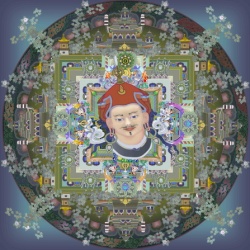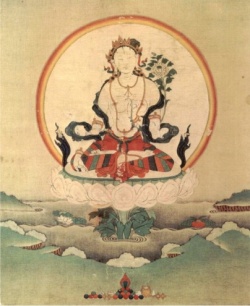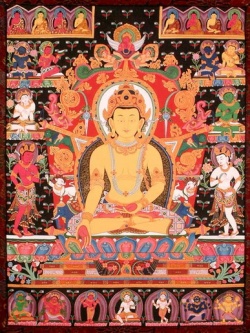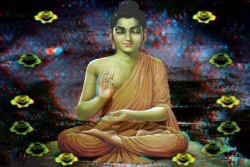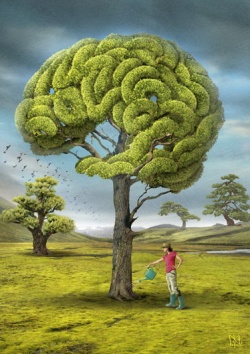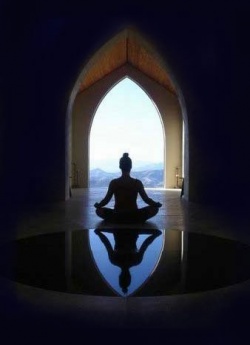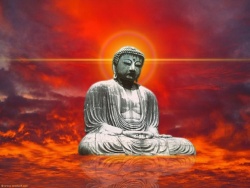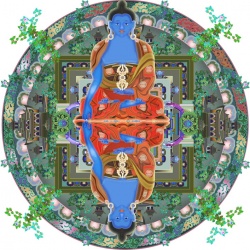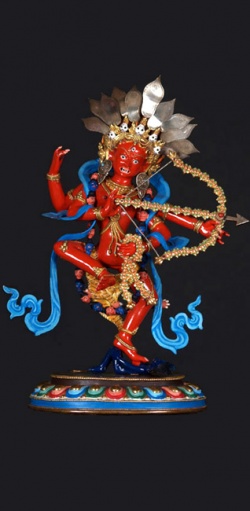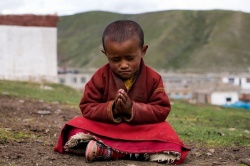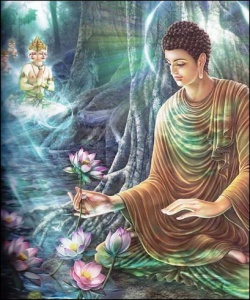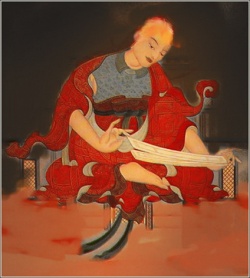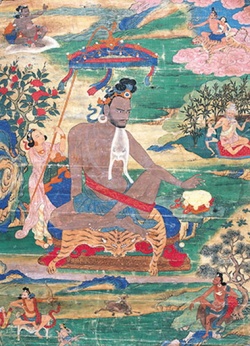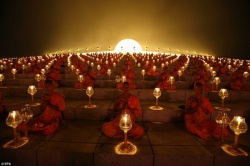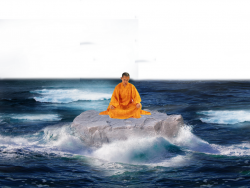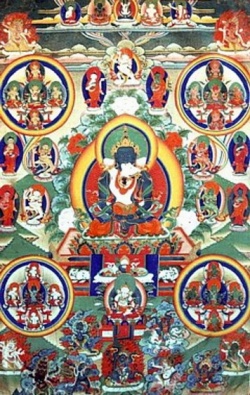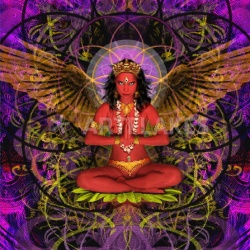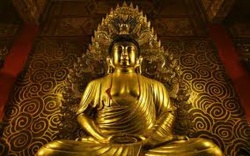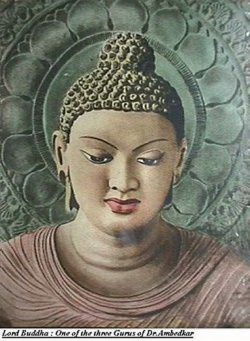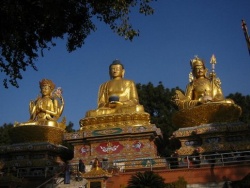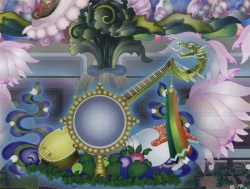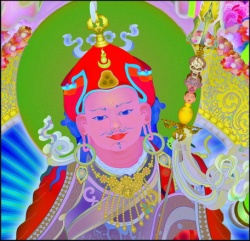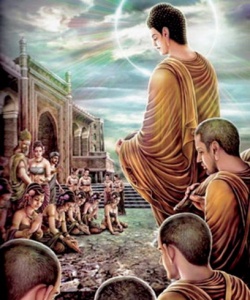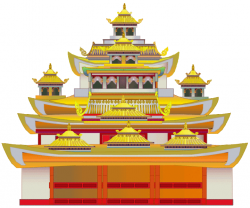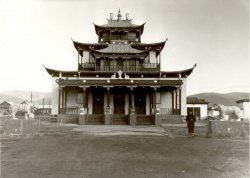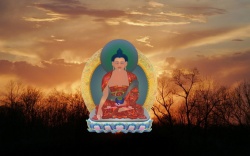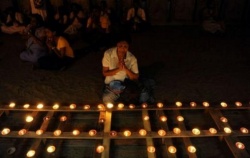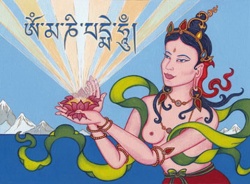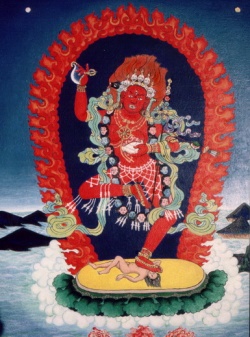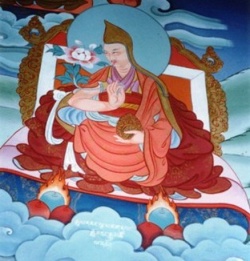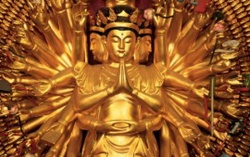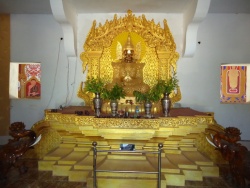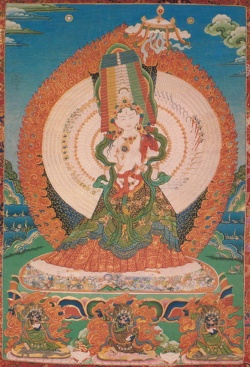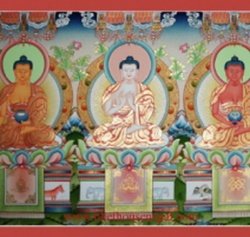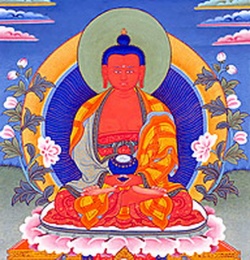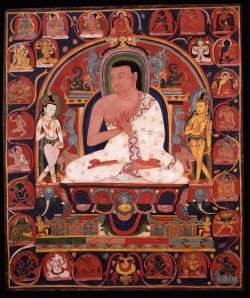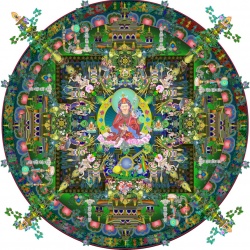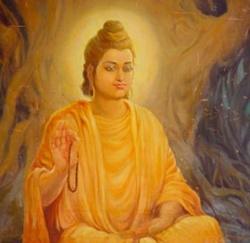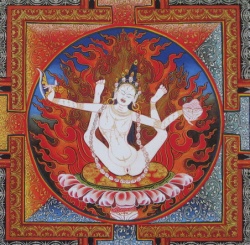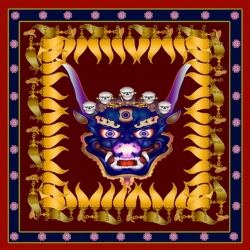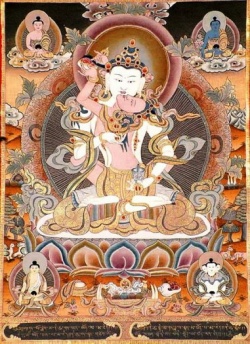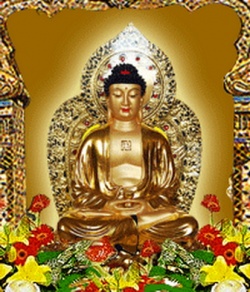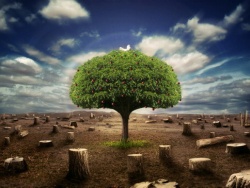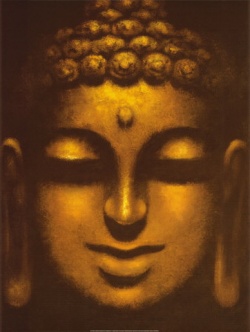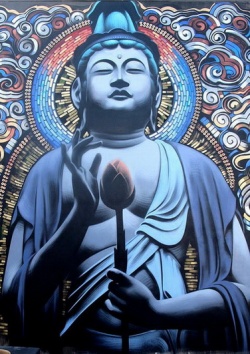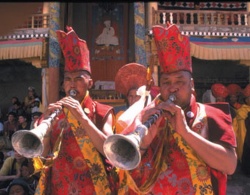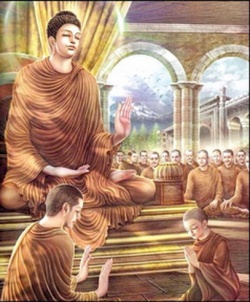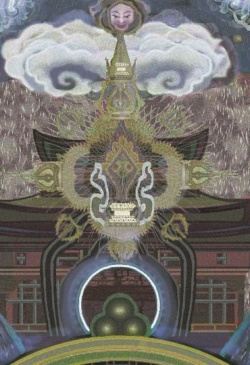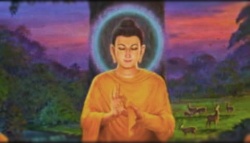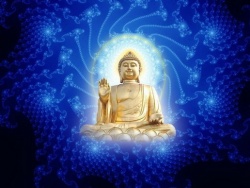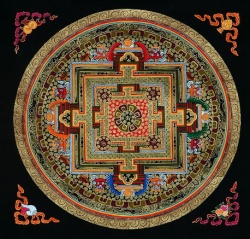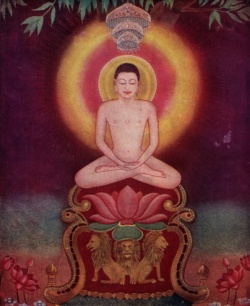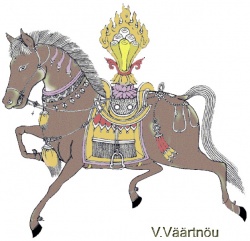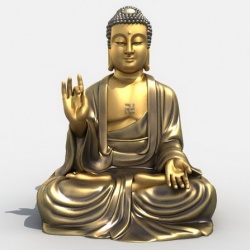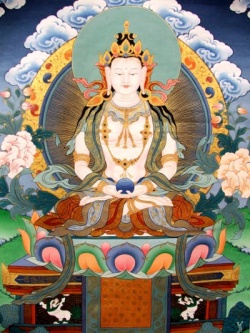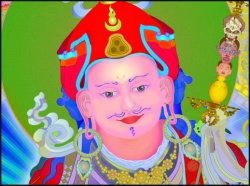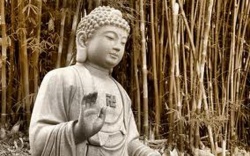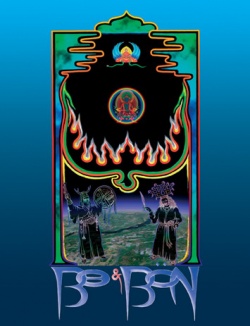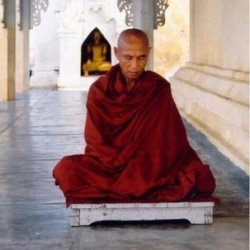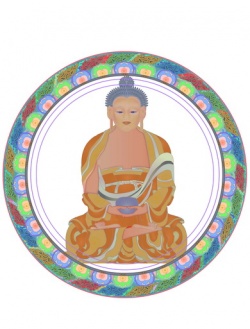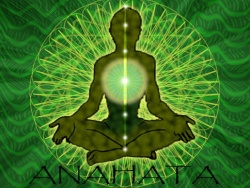Rinchen Terdzö (5)
At dinner tonight, Alexandra Kalinine described a bit of sunset chaos that erupted in the monastery courtyard in the late afternoon. A cow had found its way past the outer gate, through the courtyard, and made it as far as the steps up to the main shrine room doors. A number of young monks tried to chase it out, but the cow proved a worthy adversary, dodging the boys and some monastery dogs quite successfully. Alexandra spotted the cow from the terrace near the door to the second floor public bathroom. She was contemplating going down the steps when she saw the cow below trying to come up. Today we received all the empowerments of the last two Logos, Worldly Offerings and Praises, which was transmitted to Padmasambhava by Rambuguhya, and Wrathful Mantras, which was transmitted by Shantigarbha. There were about ten empowerments in the last two Logos. They were all brief. These two Logos are only performed by practitioners who have attained accomplishment in one of first five Logos, the transcendent group of practices.
The aim of Buddhist practice is to attain realization first and foremost, so it makes sense that the transcendent practices are the focus of the Eight Logos. The last two are rarely done. For the second day in a row we closed a little early, before seven in the evening. Usually we ended seven-thirty and sometimes after eight. It made me a little sad when we stopped the empowerments while there was still sun outside. Even after five hours of empowerments in a row, if we stop early there’s a slight feeling of loss when His Eminence leaves. I had the strangest thought yesterday, I could do this again. I shared this with someone else who said she felt the same way: “When’s the next Rinchen Terdzö?”
Jinpa, Shambhala’s monastic at the Rinchen Terdzö, has risen further up the ladder in the maroon and yellow world at the monastery. A few weeks ago he played the gyaling at the side of the room as the rinpoches and lamas made their way through the crowd with the empowerment articles in the evening at the conclusion of the empowerments. Today at one o’clock, he played the gyaling as part of the trio of monks who led His Eminence to and from the shrine room. Only ordained monastics can perform this function and they get to wear the dignified yellow hat. Jinpa and the rest of today’s procession was top notch.
The conclusion of the Eight Logos empowerments yesterday meant that we had finished a major section of the Rinchen Terdzö, the yidam practices. His Eminence immediately started the empowerments of the next section, called the dakini, the root of activity. The dakini empowerments began with three abhishekas of Vajrayogini, the most famous type of dakini practice. Dakinis are feminine deities. The word dakini can also refer to a woman who manifests enlightened or worldly feminine energy in a powerful or extraordinary way. In tantric literature, it is explained that women are the embodiment of prajna, transcendent knowledge, and that men are the embodiment of upaya, the skillful means of benefitting others. Several years ago I was on pilgrimage with friends in Tibet, hiking the hills of Samye Chimpu, near Samye, Tibet’s first monastery.
The brush-covered, winding ridges of Samye Chimpu are pocketed with retreat caves where a great number of termas have been discovered. For example, Jigme Lingpa’s famous cycle of termas, the Longchen Nyingtik, was discovered at Samye Chimpu in a cave that is one of the blackest places I have ever ‘seen’ (when the butter lamps are out). There were many miraculous things to discover at Samye Chimpu, such as Padmasambhava’s head-print in rock, and the self-arisen stone dais that manifested beneath King Trisong Detsen’s daughter Pemasal when Padmasambhava brought her back to life in order to teach her the Pema Nyingtik before she went on to her next birth. When we walked down one of the ridges at Samye Chimpu at the end of the afternoon, I thought I spied another cave entrance hidden in the brush. Our interpreter Dorje, a Tibetan from Amdo who’d been with us for a month and with whom we’d become quite close, heard me wondering aloud what lay beyond the path through the bushes. In his early twenties, Dorje was discovering his Buddhist roots and was eager to help us connect in whatever way he could to the dharma. Without warning, he scrambled through the brush to toward the cave and began calling out a greeting before anyone could protest that he might disturb a retreatant.
A moment later he emerged from the brush saying that it was a nice cave and he’d met a yogini that we should come meet. A yogini is a female tantric practitioner; a yogi is a male tantric practitioner. Sometimes these terms are used loosely in the West, but the basic meaning is honorific. A yogini or a yogi is someone who is genuinely practicing yoga, union with the ultimate nature of reality. In classical texts the words refer to people who are realized. The essence of the yogini principle is embodied in the sadhanas of Vajrayogini, the indestructible yogini. Getting back to the story… When we entered the cave we were introduced to an extraordinarily peaceful and kind nun with a shaven head and a simple shrine beside her. We were a bit shocked to learn that she’d been in retreat there for eleven years. After finding out that it was ok we’d just popped in, a bit of conversation ensued and she offered us tea while we talked. For me, the quality around this yogini was that nothing extra was happening. She was plainly who she was and there was no detectable neurosis around that.
I have experienced this with other people who’ve spent long periods in retreat. It’s like they aren’t experiencing discursive thoughts; there’s no echo of mental speed in what they say or how they act. The space around people like this feels somehow cleaner and saner than what’s generally accepted as normal. I don’t know how it came up, but at some point she told us that three different rinpoches had said she was a real dakini and asked her to marry them. With each one she said no, and told them she preferred to remain in retreat. At that point I asked her to tell us what it meant to be a dakini. She replied that it meant your mind was inseparable from Guru Rinpoche, Padmasambhava. We stopped the empowerments today part-way through a series of ten related Vajrayogini abhishekas found in the rediscovered termas of Jomo Menmo, a 13th century yogini who was an emanation of Yeshe Tsogyal, Padmasambhava’s Tibetan consort.
Jomo Menmo’s presence in the Rinchen Terdzö was inspiring; female tertöns are rare. Vajrayogini herself gave Jomo Menmo the terma called The Gathering Of All The Secrets Of The Dakinis when Jomo Menmo was twelve years old. Jomo Menmo, then a sheepherder, had been awakened from a nap she was taking near the entrance to one of Padmasambhava’s caves of attainment, a place where practice could be very strong. Inside the cave, a secret door opened and she joined a feast with Vajrayogini and many other dakinis. Jomo Menmo was told to practice The Gathering Of All The Secrets Of The Dakinis, but to keep it secret. Jomo Menmo was an amazing practitioner with wonderful qualities, but the majority of people where she lived believed she’d been possessed by a mountain spirit, so she took to wandering the country with no fixed destination. This style of practice was not uncommon in Tibet. Later she met Guru Chökyi Wangchuk who understood that she was Yeshe Tsogyal. For a short while she and he were consorts. Guru Chökyi Wangchuk advised her that it was not the time to reveal The Gathering Of All The Secrets Of The Dakinis, so Jomo Menmo continued to wander Tibet accompanied by two accomplished female practitioners.
Then, when she was 35, having secretly benefitted many beings, she and her two companions performed a feast on a mountaintop in central Tibet, flew off into the sky like birds, and entered Padmasambhava’s pure realm without relinquishing their bodies. Jamyang Khyentse Wangpo rediscovered Jomo Menmo’s terma in the 19th century. Jamyang Khyentse Wangpo had been Guru Chökyi Wangchuk at the time of Jomo Menmo. The Jomo Menmo empowerments were among the most elaborate and complex we received during the Rinchen Terdzö. As they were bestowed, a large group of dark skinned Indian women appeared at the door near the side of the stage. Their saris were bright solid colors: red, white, blue, yellow, green, and so on. They looked extremely shy. There were tiny girls and tall women, and they stood clustered together in a group. At first none of them even dared to step over the threshold into the shrine room.
They seemed awed by His Eminence, and most all of them had their palms pressed together at their hearts. He looked over to the group and gave them several beaming smiles as he continued the empowerments. The dakini empowerments continued today with the conclusion of Jomo Menmo’s Vajrayogini abhishekas and an empowerment of a Vajrayogini yangter from Rigdzin Gökyi Demtruchen. Vajrayogini is ‘the anthropomorphic form of shunyata,’ as Chögyam Trungpa Rinpoche once put it. She is how emptiness might look if one were to actually meet it. As a deity, she is visualized as a dancing, wrathful goddess surrounded by the flames of wisdom. She holds a knife that cuts conceptuality in one hand and a skull cup filled with the amrita in the other. Vajrayogini practice is special to the Shambhala community because it was the sadhana that Chögyam Trungpa Rinpoche taught in the most depth. Many of the students of the Mandarava, Padmasambhava’s Indian consort Vidyadhara have practiced Vajrayogini intensively at some point. It was poignant to witness such a wide variety of Vajrayogini abhishekas. It continued to be eye opening to see that there were so many ways to present the each of the practices in the collection.
Following the Vajrayogini empowerments we received two empowerments for practices of Tara, Drölma in Tibetan. Tara is sometimes translated as, ‘She Who Liberates’. Tara is sometimes described as compassion embodied in a human form. One of her principal expressions of compassion is to liberate beings from fear. The great Indian teacher Nagarjuna wrote a praise to the twenty-one forms of Tara. Most, if not all, of the lineages of Tibetan Buddhism have a wide range of Tara practices. Sakyong Mipham Rinpoche has written a short Tara practice and there is at least one short Tara supplication in the collected Tibetan works of Chögyam Trungpa Rinpoche. Tara’s story is relevant to all of us. Khenpo Tsültrim Gyamtso Rinpoche explains that kalpas ago Tara was born as a virtuous and gifted being with great faith in the dharma and the Buddha of that era. At that time she was a princess named Yeshe Dawa, Moon of Wisdom. She had an enormous ability to practice the dharma and through this had a glimpse of supreme bodhicitta, the heart of enlightenment. At that time, all the ordained monks around urged her to pray that she to be born as a man through the power of her merit so that she could accomplish great benefit for the teachings.
The story continues:
This seemed a mistaken understanding to Princess Yeshe Dawa. So, she replied: “Here, there are no men, there are no women, There is no self, no individual, and no perception. These labels of ‘male’ and ‘female’ are meaningless, They are the utter confusion of weak-minded worldly beings.” Thus she taught the equality of all things. “Many are those who wish to attain enlightenment with a male body, But no one wishes to do so with a female body. Therefore, with a female form, till samsara is emptied, I will vastly accomplish the benefit of beings.” Thus she vowed.9 And so Tara has continued to benefit beings to this day in a female form. Tara’s two most popular practices are White Tara and Green Tara. White Tara is known for conferring vitality, healing, and also fertility. In a monastery near Swayambunath Stupa in Kathmandu there is a 9 Khenpo Tsültrim Gyamtso Rinpoche composed these two verses in 1997. They are part of his text, The Origin Of Tara In Brief, translation by Chryssoula Zerbini, copyright 2010, Marpa Foundation.
White Tara statue that has actually spoken on occasion. The statue wears many jeweled necklaces that were given to her by women who’d been unable to conceive until they came and made prayers before her. There is a speaking Tara at the Mahabodhi Stupa in Bodhgaya too. Green Tara is associated with protection and activity. People often practice Green Tara when travelling. The 16th Karmapa practiced Tara when taking off and landing in airplanes. As for what Tara protects us from, there are lists of 21, 16, and 8 kinds of fears. The eight fears to be protected from are the fears due to lions, wild elephants, fire, snakes, thieves, imprisonment, floods, and demons.
Some of these fears are more rare in the modern world than they were in ancient India. However, Orissa is still a place where cobras, tigers, and elephants roam wild, and Shambhala Mountain Center is sometimes host to rattlesnakes, mountain lions, and bears. These eight fears are sometimes connected with eight negative states of mind: pride, delusion, anger, jealousy, wrong views, avarice, desire, and doubt. Tara’s vow is that she will manifest to those who sincerely request her help during times of great distress.
Shambhala and Padma Ling students again joined together for Padmasambhava feast in the old monastery this evening. Yesterday there was a minor controversy about when the actual feast day was. Several Westerners were adamant it was on the 4th of February. However, the chöpöns at the monastery, who very kindly make extra tormas for us on feast days, were firm in their position that today was the day and therefore would not make us a torma on the 4th. So, we did the feast on the 10th lunar day, as it was perceived in Orissa. The lunar calendar is used to reflect the interrelationship between the flow of energies in the body and the movement of outer energies like the sun and the moon. The Westerns students decided to do a single feast with one of His Eminence Namkha Drimed Rinpoche’s termas of Padmasambhava rather trying to do two simultaneous feast practices the way we did last month. This suited our international group well because we could sing the liturgy together in Tibetan.
At one point, we came to what is known in Shambhala as the Jigme Lingpa Feast Offering. This we did three times in Tibetan and then three times in our own languages, all at once—French, Spanish, German, and English. Feast again included arak, the locally brewed hard alcohol, which some of us mixed with orange soda. After the practice, a few well-behaved dogs that sleep in the trees next to the old monastery gobbled up the leftovers. Earlier in the day I met with the Sakyong. He had been very busy writing during the breaks in the empowerments and this was the first meeting with him in several weeks. The
Sakyong was relaxed and happy. He remarked that this event was somewhat historic in that it may have been the first time a Western audience has really been let in at the Rinchen Terdzö. He pointed out that in the early years, Westerners would never be allowed to ask the chöpöns questions. To be able to walk into the chöpön’s room and ask how to read the abhisheka outlines, and be able to check over what happened at the end of each day, has been a real blessing. Our own three-year retreatant, Kristine McCutcheon, has made some of the tormas used in the abhishekas, which is another sign of our ability to meet the tradition. Today we continued with the dakini empowerments. These alternated between different forms of Vajrayogini and Tara. We also received the Taksham terma practice of Yeshe Tsogyal. This empowerment was lengthy and, of course, a special moment for the monastery. Tomorrow we will we start with Dechen Gyalmo, the famous dakini practice from the Longchen Nyingtik, which was bestowed by His Holiness Dilgo Khyentse Rinpoche at Karmê Chöling, in Boulder, and in Halifax in 1987.
[This letter was sent from the Sakyong Wangmo, Dechen Choying Sangmo to the Shambhala Community during the Rinchen Terdzö.]
Dear Subjects of Shambhala, ! Even though I am far away from many of you, you are in my heart. I am constantly thinking of you all and wondering how you are doing. !My husband, the Sakyong, jokes that this is the marathon of abhishekas, and having entered the dakini section, in the third month of the Rinchen Terdzö Empowerment, completing about five hundred abhishekas, I am beginning to agree with him. !
The days are passed essentially in group retreat, much like the dathüns in Shambhala. Every day is basically the same, and every evening, with a large gathering of lamas, monastics, and lay people, we all do aspiration prayers dedicated to all sentient beings. ! Here in Orissa, we have both the monastic community of monks and nuns, and the lay people attending from the five main Tibetan refugee camps as well as from all over India and the Himalayan region. There are also many adventurous students from Shambhala and Ripa (students of my brother, Jigme Rinpoche, from Europe and the U.S.) It is amazing to see these different cultures gathering together under one mandala, devotedly receiving the abhishekas.
This reminds me of what the Buddha said, about how the dharma would gather together all races and all cultures. !I am very moved by how my father, His Eminence, Tertön Namkha Drimed Rinpoche, is taking such care in passing the lineage on to the Sakyong. And I am delighted that there have been fundraising parties and gatherings to support this. For those of you who could not be here, this is a wonderful way to contribute and participate from afar in the Rinchen Terdzö empowerments. I hope that in the future, many of you will be able to come and visit the monastery and see the surrounding community. !I cannot express how meaningful the Rinchen Terdzö is for our community.
Many local people see His Eminence putting so much time and effort into this, and they have told me—especially some of the older ones who escaped from Tibet—how fortunate they feel that such a major teaching is taking place. The community members often thank me, saying how grateful they are that the Sakyong requested and is sponsoring this historic event. Everyone is benefiting tremendously whether near or far, and to think, all this is happening because of our marriage! How amazing! Ki Ki So So! ! Yours in the vision of the Great Eastern Sun, ! The Sakyong Wangmo, Dechen Choying Sangmo !
Jamgön Kongtrül Lodrö Thaye didn’t create the Rinchen Terdzö alone. His main inspiration and guide was his guru, Jamyang Khyentse Wangpo (1820-1892). In an interview last week, Jigme Rinpoche stressed how crucial Jamyang Khyentse was in the development of the collection. He said: Jamgön Kongtrül’s source of authenticity and approval for the termas was Jamyang Khyentse, Pema Ösel Do Ngag Lingpa (Jamyang Khyentse’s tertön name.] He was also Jamgön Kongtrül’s teacher. For Jamgön Kongtrül, the only person who could definitely authenticate was Khyentse. Jamgön Kongtrül did more work on the Rinchen Terdzö, but the actual source was Khyentse.
This is because so many of the termas teachings included in the Terdzö were almost extinct, and some were actually extinct. Somehow, Do Ngak Lingpa, Khyentse, brought these back to life through his visions of the earlier tertöns. Jamyang Khyentse Wangpo was born in Derge, eastern Tibet. He was an exceptional rebirth who even as a child had a strong motivation to help others and a desire to become a monastic. In his youth he could recall his previous lives. The presence of the protectors Mahakala and Ekajati seemed to accompany him and, on some occasions, they were actually visible to people with him. He was like many other tertöns described in this blog, a brilliant scholar who was a voracious learner.
From an early age, Jamyang Khyentse Wangpo had many visions of teachers and deities. His termas, based on his clear recollections of previous lives, and his pure visions are voluminous. We received empowerments related to his discoveries at least every other day during the Rinchen Terdzö. One reason for the large number of his discoveries was that when he was forty, after being supplicated repeatedly by Jamgön Kongtrül for help in recovering the ancient termas, Jamyang Khyentse Wangpo was blessed in an extraordinary way by Padmasambhava during a pure vision. As a result, Jamyang Khyentse Wangpo was able to see all the tertöns and terma teachings from the past, from his time, and from the future that would arise in Tibet. Even with all these accomplishments and the ability to see all tertöns and termas, Jamyang Khyentse Wangpo still continued to study impartially with teachers from all lineages, 150 different teachers in total. This led him to study or receive the transmissions of over 700 volumes of teachings. This kind of manifestation is inconceivable from the standpoint of ordinary academic ambition. It absolutely does not make sense that someone of such realization would so diligently continue on the path of study.
The only way to understand what Jamyang Khyentse Wangpo did is to see it from the point of view of helping others by gathering, preserving, and spreading the teachings. Khyentse Wangpo said that he’d made no more progress on the realization of mind’s nature after receiving a particularly profound set of teachings at the age of nineteen. This might sound like he is being humble somehow, but it actually shows that he was already completely realized at the start of his brilliant and magnificent life. This is how he accomplished so much. Besides preserving the dharma through teaching, explanations, and practice, Jamyang Khyentse built many libraries, constructed and restored numerous monasteries, and he commissioned a large number of statues as well as many woodblock and handwritten editions of scriptures. Printing was very important in 19th century Tibet, a place with relatively poor means and still using woodcuts for printing texts.
Although miracles are not the point, it’s both poetic and inspiring that the rice Jamyang Khyentse threw in offering to the principal statue of the Buddha in all Tibet, the Jowo in Lhasa, spontaneously turned into white flowers. Rice tossed in offering is a substitute for flowers. At the age of 72 Jamyang Khyentse Wangpo passed away. At the time of his passing there were gentle earthquakes and his face was said to be as radiant as that of the moon. His body became as light as cotton. This sign is in an indication of the attainment of rainbow body, the exhaustion of the coarse and subtle defilements and fixations in a great meditator. Cynthia writes: In this painting, Jamgön Kongtrül turns to his right and bows his head towards the flaming jewels in front of his seat. With this simple direct gesture, he is exemplifying to us the honor to be given to the Buddha, his teachings, and the community of practitioners, and to the consequent realized masters over time, the personal yidams, the dakinis and dakas, and all the protectors of their mandalas. Kongtrül holds his hands in the dharmachakra mudra at his heart level. It is the gesture of turning the wheel of dharma thus activating the teachings in our world system.
Two lotus flowers are seats for the purity and liberating capacity of Kongtrül’s enlightened qualities, which are symbolized by the flaming sword rising above the Perfection Of Wisdom10 text on his right, and the auspicious vase topped by a symbol of tendrel chingwa, the interdependent relationship that is the nature of all phenomena. This symbol—derived from the Sanskrit root sv-asti, meaning well-being and good fortune—also indicates prosperity. Turning in a clockwise direction, the reverse swastika symbol is considered the seal of the Buddha’s heart, expressing the powerful illuminating radiance that the Enlightened One extends to all, like the rays of the golden sun.
The fullness yet emptiness of the gold vase to his left indicates Lodrö Thaye’s embodiment as the union of wisdom and compassion. The sun and moon circles in the sky represent the red and white bindus fully mature. This is another visual sign of the inseparability of absolute and relative bodhicitta, which is the vital heart essence of Jamgön Kongtrül Lodrö Thaye’s manifestation. I painted this image many years ago, while Kyabje Kalu Rinpoche was living in this world. The composition wasn’t complete with landscape and a few other details until recently. When Kalu Rinpoche saw the image, he blessed it by writing in his own hand the seed syllables for the three chakras on the back of the work. He mentioned some of the enlightened qualities of the Great Lodrö Thaye as kind and gently refined with great humility. In our lifetime, His Eminence Kyabje Jamgön Kongtrül Rinpoche is considered the mind emanation of Kongtrül Lodrö Thaye, Dzigar Kongtrül Rinpoche is considered the speech emanation, and Kyabje Kalu Rinpoche is recognized as the activity emanation.
Maggie Smith arrived with Allya and Paul Burke today. Their jeep pulled into the small parking lot in front of the guesthouse at teatime. At that moment, most of the lay people attending the empowerments had also arrived in the parking lot. They were on their way home because the rest of the day’s empowerments were restricted. The dusty white four-byfour carrying the new guests had to creep through a crowd of a few hundred Tibetans who were on foot or revving motorcycles in front of the guesthouse. A cow relieved herself in front of the jeep as it finally rolled to a stop. Asked later if the crowd had slowed their arrival, Maggie cheerfully replied, “No more than anything else on the way here.” Today we completed the dakini section of the Rinchen Terdzö, the section devoted to the feminine deities that are the root of enlightened activity. We finished with a flourish of 10 Prajnaparamit practices for Tara, Vajravarahi, Guhyajnana (Secret Wisdom, a deity mentioned in Jamgön Mipham’s Great Clouds Of Blessing), Mandarava, and Yeshe Tsogyal. The very last empowerment in this section was for a chöd practice in the Mindroling tradition. Chöd practice is interesting.
Generally speaking, the main part of the chöd practice begins with the ejection of consciousness. One visualizes that one’s consciousness leaves one’s body of flesh and blood through the crown of the head, and one arises in a form of Vajrayogini, the embodiment of wisdom. Then one imagines offering one’s ordinary body, blessed as divine food, to all enlightened beings, all suffering beings, those with whom one has karmic debts, and all spirits and demonic forces who want to do harm to others. This kind of visualization develops insight into emptiness along with strength of compassion, and it helps one to relate more sanely to fear and death. Sometimes advanced practitioners deliberately practice chöd in frightening places like charnel grounds where corpses are cremated or fed to vultures. The Asian belief is that ghosts lurk in charnel grounds, so practice in such places gives one greater opportunities to work directly with fear and confusion. Ultimately, all appearances in life and death are manifestations of the mind. The idea of a ghost or demon vanishes with the genuine realization of this insight.
For the best practitioners, chöd practice in a charnel ground can be a fast track to that realization. The word chöd means to severe or cut. One cuts one’s idea of there being a self. Selflessness is an unfamiliar concept in the greater Western world. We aren’t used to entertaining the idea that beneath our day-to-day thoughts and activities, the underlying assumption of a ‘me’ being there is an unnecessary addition. However, it’s not that absolutely nothing is happening, that there’s absolutely nothing and nobody there. Selflessness means that our assumption of a ‘me’ (or for that matter, something outside called an ‘it’) as an unchanging, permanent thing separated from everything else in the world is a form of confusion. The teaching of selflessness points out that what we think of as the ‘me’ is not there. Even though the ‘me’ can’t be found, we function anyway. We don’t need to rely on the idea of ‘me’ in order to function in life.
The cause of our suffering turns out to be thoughts and actions attached to the idea of a ‘me’ as being something real we have to defend. If this understanding is brought to bear both on the ‘me’ as well as on the rest of our experience, insight and the capacity to help others will blaze like a bonfire. Chöd practice became popular because of Machig Labdrön (1031-1129), the most famous female practitioner in Tibet after Yeshe Tsogyal. Her name means Only Mother, Lamp of Dharma. It is said that when she was a baby, a third eye visibly emanated from her forehead. This was not like a normal eye, but a sign of divinity, and people had great faith in her. Machig Labdrön was very, very intelligent. One sign of this was that she had an incredible ability to read. A good reader can read one volume of Tibetan text aloud in a day. An exceptional reader can read aloud three volumes in a day. Machig Labdrön was able to read twelve volumes in a day. They say she could see the back and front of several pages at once. When she spent a month reciting the twelve-volume, 100,000 verse Prajnaparamita Sutra thirty times in succession she gained complete enlightenment.
The Prajnaparamita sutras are the most thorough presentation of selflessness spoken by the Buddha in the mahayana tradition. Machig’s achievement was unique in Tibetan history because it is difficult to attain complete realization in one life through recitation of Prajnaparamita, a mahayana method, as opposed to relying on the vajrayana methods of visualization, mantra recitations, inner yogas, and so on. Mahayana methods are said to be gradual and can take many lifetimes to perfect; vajrayana methods are explained to be much faster. Machig later combined her realization of Prajnaparamita with the chöd practice that she’d received from the Indian siddha Padampa Sangye. Her teaching became so popular that it was even brought to India. It was the only practice from the Tibetan tradition that was certified as valid by the Indian panditas, the most learned practitioner-scholars of that era. Following our afternoon tea break, His Eminence began the empowerments of the protector section of the Rinchen Terdzö. Protectors are the embodiment of the environment of awareness that surrounds and protects the dharma. Chögyam Trungpa Rinpoche gave his students a practice called kasung to train people in embodying the protector principle.
Ka means command or teachings, and sung means to protect. Kasung is one of the Tibetan words for protector. What protects the dharma, what protects goodness and sanity, is awareness, not weapons or aggression. For example, during a formal teaching, a few people doing kasung practice will sit on the perimeter of the shrine room while maintaining awareness of the overall situation as opposed to taking notes or exclusively listening. One of the mottos of the kasung is, “Victory Over War.” The focus of kasungship is creating and protecting an environment of warmth and decency. The protector principle, besides being a practice, is also an experience. While usually gentle, sometimes the experience of protector principle can be sharp. One of the most direct experiences I’ve had of this occurred in 1987 while I loaded food cartons into Karmê Chöling’s basement during the visit of His Holiness Dilgo Khyentse Rinpoche.
I was distracted and making up a loud, senseless rhyme as I stood receiving boxes part way down a storm door stairwell into the basement. I was near enough to Khyentse Rinpoche’s window to be heard by His Holiness or anyone is his room, but I was oblivious of that. Suddenly one of the steel storm doors became unbalanced and slammed straight down on the top of my head. I was not hurt, but my energy was cut completely. It felt like being slapped awake. While the door falling on my head was pure coincidence, the message was clear, ‘Watch your mind.’ Protector practice makes us more sensitive and available to making that kind of connection. Such sensitivity is particularly important on the contemplative path. One wants to avoid the sidetracks of aggression, self-absorption, grasping, and other neuroses because they can upset stabilization of compassion and insight.
Working with protector principle guards one’s development and sustains the general environment of the teachings. There are many different types of protectors just as there are many different gurus and yidams. Different termas have different protectors, as do different lineages, teachers, places, and types of teachings. There are many stories of realized teachers actually meeting the protectors and yidams as if in person. These kinds of stories are beyond our everyday experience and are provocative to think about. My personal feeling about this is that if someone completely realizes and embodies the teachings, the energy around them becomes quite intense. Chögyam Trungpa Rinpoche’s poem titled, Meetings With Remarkable People, gives some insight into an enlightened being’s experience of the deities. The poem begins a vivid description of meeting with three protectors and concludes with: I witnessed these extraordinary three friends in the flesh. Surprisingly, they all spoke English. They had no problem communicating in the midst of American surroundings.
What do you say about this whole thing? Don’t you think meeting with such sweet friends is worthwhile and rewarding? Moreover, they promise me that they will protect me all along. Don’t you think they are sweet? And I believe them, that they can protect me. I would say meeting them is meeting with remarkable men and women: Let us believe that such things do exist. p. 125 The word ‘protector’ is a short way of saying dharma protectors, or chökyong in Tibetan. They carry out the four enlightened actions of pacifying, enriching, magnetizing, and destroying. They can be divided according to whether they are a wisdom, action, and worldly protector. Wisdom protectors or dharmapalas can be male or female and are known as ‘great black ones’, or mahakala and mahakali in Sanskrit. These are fully enlightened beings sometimes indivisible from a deity like Avalokiteshvara. Action protectors carry out the wishes of the wisdom protectors and are part of their retinue. Worldly protectors (Skt. lokapala) are not fully enlightened, but have taken an oath to protect the teachings and practitioners.
The protector section of the Rinchen Terdzö is divided into a section for the mahakalas THE GREAT RIVER OF BLESSINGS 172 and action protectors, and a second section for various other protectors, principally the female wisdom protectors. The second section includes, for example, mahakali like Ekajati and lokapalas like Magyal Pomra. A short section related to Bön deities and protectors follows the protector section of the Rinchen Terdzö. ;4C,/'%E,/%;+F),-)% =)@.C#.N%X$"% This morning it was still dark when I started work on the blog. Outside, there was a steady soprano chorus of crickets chirping. In the distance an overtaxed radio blared Hindi music at the other end of camp four. Occasionally, the sound of a ritual bell made its way over from the monastery to the bathroom window where I quietly typed as Patricia slept.
On the rare mornings when I got up around four o’clock, I heard the gyalings accompanying His Eminence from his bedroom in the monastery to the shrine room for his morning practice. With the coming of dawn around six o’clock, the ravens started their array of calls from the mango trees in our neighbor’s yard. Some people thought they were mina birds because their calls were so varied, like little children playing with sounds for fun. Then, small twittering birds that looked like finches added a high background chorus to the backyard symphony that accompanied the coming daylight. About this time, the human sounds started. First, a day helper at the neighbor’s house shouted to wake someone to inside to unlock the door. Then, a calling gong rang from the monastery, and at around 6:20 the first bus from the other camps in the Tibetan settlement bugled and grinded its way towards the monastery gates. In the guesthouse, one or two alarm clocks beeped and were swiftly silenced. At 6:30, the voice of the umdze leading morning chants was broadcast from the loudspeakers perched on the monastery roof, and afterwards the sounds of the reading transmission filled the valley with Lhunpo Rinpoche’s powerful staccato.
The lung soon became the main aria for the morning, surrounded by the occasional themes of motorcycle engines, barking dogs, and mooing cows. This all continued until around 8:00, when the first part of the day eased into breakfast in the monks’ dining room, the canteen, the guesthouse, and the various houses around the village. The protector empowerments turned out to have a different atmosphere than the empowerments for the guru, yidam, and dakini. All the protector empowerments were restricted to monastics and people who’d completed ngöndro and could keep the commitment of either daily protector practice or attending a feast that included a protector sadhana at least once a month. Along with the monastics, the group remaining in the shrine room included fifteen or twenty Tibetan and Bhutanese tantrikas (non-monastic vajrayana practitioners, all wore robes), a handful of lay people, and most, if not all, of the Westerners who’ve completed ngöndro.
Since the size of the assembly had reduced itself by half, the doors to the huge shrine room could be shut instead of being left open to the veranda. The environment was considerably more quiet and grounded. Over the last two days we moved quickly through the list of protector empowerments. Some of the abhishekas were skipped because we had already received them during the guru or yidam section. This was the result of the 15th Karmapa’s ordering of the Rinchen Terdzö. Many protector empowerments were quite short, which also sped up our pace. Today we also learned that the official conclusion of the Rinchen Terdzö was now set for just after the start of the New Year. At that time His Eminence would formally enthrone the Sakyong and Lhunpo Rinpoche as holders of the Rinchen Terdzö lineage. I thought it would be interesting to list some of the protectors we were introduced yesterday and today because many are already practiced in Shambhala. The first was Ganapati, who is mentioned in The Invocation for Raising Windhorse. Ganapati is an emanation of Avalokiteshvara.
We also received the rest of the five Ekajati empowerments in the Rinchen Terdzö. Ekajati is one of the main protectors of the Nyingma teachings, and is practiced at several different centers in Shambhala. Ekajati practice began at Karmê Chöling because Chögyam Trungpa Rinpoche said that eventually the dzogchen teachings would be given there. Next we received empowerments for Achi Chökyi Drölma (practiced during the Söpa Chöling three-year retreat), and for Dorje Yudrönma, the protector associated with the Vidyadhara’s mirror divination practice. Many of the protectors were guardians of specific terma cycles. Some of the protectors were connected to the kama, the oral lineage of the Nyingma that has come down uninterruptedly from the time of Padmasambhava.
Many of us enjoyed watching a particularly little monk. He was among the youngest monks living at Rigön Thupten Mindroling. Watching him prostrate was entertaining and sweet because it was a bit of a battle between him and his robes. He and another monk about his age often hid near the shrine room door to get a close look at His Eminence’s arrival in the afternoon.xtremely young children come to a monastery it is sometimes due to family misfortune. I remember a very young monk at Benchen Monastery in Kathmandu several years ago. He would wait near the shrine room door at the end of the teachings every day so that he could be sure to have a place beside Tenga Rinpoche at afternoon tea. He was so small that even standing he was barely taller than an adult sitting on the floor. Both of this monk’s parents had died suddenly in a car crash. At two years of age he had been placed in the care of Tenga Rinpoche and the monastery. However, the little monk in Orissa had a different story.
The Sakyong Wangmo told us that his name was Dorje and that his parents were allowed to give him to the monastery at an extremely young age because even as a baby he displayed many habitual tendencies towards practice. The Sakyong Wangmo added that several of the older monks who have remained at the monastery after finishing their education have a similar story. I am pleased to present the first in a two-part post from Acharya Fenya Heupers. Fenya was following the blog and sent a compilation of her notes from a seminar given by the Vidyadhara Chögyam Trungpa Rinpoche in 1974. The seminar focused on three different Jamgön Kongtrüls. The first, Jamgön Kongtrül Lodrö Thaye (also known as Jamgön Kongtrül the Great), lived in the 19th century and compiled the Rinchen Terdzö. He was a guru to many great teachers, including Chögyam Trungpa Rinpoche’s prior incarnation, the 10th Trungpa, Chökyi Nyinche. After Jamgön Kongtrül passed away he had two simultaneous rebirths. Having multiple rebirths is not uncommon for great teachers. Both of these rebirths counted the 10th Trungpa among their gurus. The first rebirth of Jamgön Kongtrül Lodrö Thaye was Jamgön Kongtrül of Shechen, meaning Shechen Monastery.
He was one of Chögyam Trungpa Rinpoche’s root gurus and he bestowed the Rinchen Terdzö upon Chögyam Trungpa Rinpoche. The second rebirth of Jamgön Kongtrül was Jamgön Kongtrül of Palpung (Palpung Monastery) who gave Chögyam Trungpa Rinpoche his monastic vows. Although Acharya Heuper’s notes and quotations are not the exact words of Chögyam Trungpa Rinpoche, they have the raw feeling of his teachings. The quotations in the notes are Stories of the Kongtrüls from the Vidyadhara Chögyam Trungpa Rinpoche By Acharya Fenya Heupers On the joyous occasion of transmission of the Rinchen Terdzö, when Sakyong Mipham Rinpoche becomes the lineage holder of this tradition of his father, the Vidyadhara Chögyam Trungpa Rinpoche, through the tremendous kindness of his father-in-law, His Eminence Namkha Drimed Rinpoche, I remembered teachings of the Vidyadhara on Jamgön Kongtrül.
In November and December 1974, Chögyam Trungpa Rinpoche gave a seminar in Boulder on Jamgön Kongtrül Lodrö Thaye. He taught about his root guru Jamgön Kongtrül of Shechen and what it means to study with an authentic teacher. He also talked about Jamgön Kongtrül Lodrö Thaye, who collected endangered teachings and empowerments in various collections, the Rinchen Terdzö being one of these collections. Jamgön Kongtrül Lodrö Thaye was part of a renaissance of Tibetan Buddhism in the 19th century, known as the Rime, or nonsectarian, movement because this group of teachers did not want to fixate on sectarian differences between the various schools. In those days the Vidyadhara used the word ‘ecumenical’ for Rime, a word that Westerners were familiar with from the Christian tradition. The Vidyadhara explained the difference: “Rime is not as naive as the 20th century ‘ecumenism’. That ecumenism says: we are brothers and sisters, why do we fight? There is good intention in that, but the reality is that we, as human beings, are all brothers and sisters, and that’s why we fight.
There is no reason for fighting if there is no communication. The biggest problem is trying to unify the cosmos and to structure it so that everybody eats jellyfish and everybody drinks milk. If we give up hope of unifying the world, and accept chaos as it is, there is a possibility, then there might be peace. It is uncertain whether harmony is the answer to develop peace. Jamgön Kongtrül accepted chaos as well as orderliness. He was able to find profundity within complication.” Chögyam Trungpa Rinpoche also explained how sectarianism came into existence: “The teachings originate from experience, and are expressed in words, then the words are recorded and become doctrines. Logic is needed to prove the validity of these doctrines and then there is a battlefield and clashes between the doctrines because they cannot understand each other’s language. Finally there is complete confusion; intoxicated in their own doctrine, they cannot see the other doctrines.” The Rime movement brought back the contemplative tradition, which is a complete approach to buddhadharma, including both learning and practice, understanding and intuition. Sitting without learning is like wandering blindly; learning without sitting practice is like trying to climb a rock with crippled arms.
The understanding of buddhadharma is experiential; it is not rejecting scholarship, but including it. That demands dedication and devotion. Without those we are working only on the surface. So Jamgön Kongtrül had two approaches: to conquer the ocean of learning and to conquer the space of practice. In order to do so, one has to commit oneself 200%. Not that you do not eat or sleep, but they are included in that commitment. Bringing learning and practice together is not difficult. It is like stepping on dog shit; you know what you’ve done, you smell it, experience it, so there is a complete experience of intellect and intuition at the same time. Jamgön Kongtrül of Shechen used to ask, “How do you feel about it?” instead of asking about facts and figures. The contemplative tradition is personal living experience. So he seemed to be more pleased with Trungpa Rinpoche’s critical attitude than with acceptance. Jamgön Kongtrül the Great first trained himself thoroughly in the Kagyü tradition; he was a fully ordained monk. He had to live very humbly, had to beg. He learned basic solid Buddhism, about mind and emotions according to the hinayana, about bodhisattvas in the mahayana, and about the play of phenomena of tantra.
Jamgön Kongtrül established himself in Palpung, at Jewel Rock, home of devis and dakinis. He studied texts very arduously to the light of a butter lamp or just the red glow of an incense stick. He practiced meditation with stinging nettles around his meditation box. If he fell over to sleep he woke up by the stinging. He was very austere, but loved metaphysical jokes. He was a great punster. After a solid training in one tradition, he studied under 100 masters of various schools. After him these schools faded out. In this way he revived the contemplative tradition. He worked together with the tertön Chogyur Lingpa, with Patrül Rinpoche from the Nyingma tradition, and with Khyentse Rinpoche from the Sakya tradition. He brought together teachings from the eight Buddhist traditions in Tibet, and brought them into the contemplative tradition.
The 10th Trungpa was a student of Jamgön Kongtrül the Great. Frustrated by spiritual materialism he suddenly decided to escape from his monastery and studied with Jamgön Kongtrül the Great. Then he returned to his monastery (Surmang) and realized that it was not so evil, that he did not have to become a mendicant monk. He was planning to visit his guru again; then he heard that his guru had died. He continued his life of practicing meditation.”
This is the second and final installment of the post from Acharya Fenya Heupers, Stories Of The Kongtrüls From Chögyam Trungpa Rinpoche. We pick up with Chögyam Trungpa Rinpoche’s description of the two rebirths of Jamgön Kongtrül Lodrö Thaye. Jamgön Kongtrül had two incarnations: Jamgön Kongtrül of Palpung and Jamgön Kongtrül of Shechen. Jamgön Kongtrül of Palpung was a son of the 15th Karmapa. The 15th Karmapa was a student of Jamgön Kongtrül the Great, and had decided to follow his discipline and tradition in the Kagyü order as a married man. This created an uproar. One Kagyü khenpo teacher had wept for seven days when he learned that the Karmapa had married and taken off the monastic robes. The Karmapa proclaimed that his marriage was in keeping with the Kagyü tradition.
Then the Khenpo had a vision of the 15th Karmapa in Vajradhara costume with a black hat.11 The 15th Karmapa’s son turned out to be the first incarnation of Jamgön Kongtrül. Jamgön Kongtrül of Palpung also found everyone very materialistic and felt that the monastic people wanted to use him to get gifts from benefactors and disciples of Jamgön Kongtrül the Great. So he also decided to escape as the 10th Trungpa had done earlier. He went to the 10th Trungpa and demanded ordination. The 10th Trungpa hesitated because he did not want to make enemies with Palpung, but finally he gave him ordination and Jamgön Kongtrül became his student. The other incarnation, Jamgön Kongtrül of Shechen, wanted to be a student of the 10th Trungpa as well as another Rinpoche from Shechen.
He had hardships and he camped around monk’s houses until the abbot of Shechen monastery created headquarters for him with a tutor and attendant. As a teenager Jamgön Kongtrül of Shechen was very stern and he did not talk very much. Once he warmed up he was very verbal. He was extraordinarily dedicated to learning. The Vidyadhara heard 11 The black hat is a symbol of the Karmapa’s lineage. from an older disciple of the 10th Trungpa that when he visited the room of Jamgön Kongtrül of Shechen there were books all over the place. He was sleeping on them, there were pages all over, but he could find the right page. He had extremely bad eyesight from straining too much to read. His guru sent him up to a cave to meditate for several years at a time. The Vidyadhara Chögyam Trungpa Rinpoche was ordained by Jamgön Kongtrül of Palpung, and received meditation instruction from Jamgön Kongtrül of Shechen. In working with Shechen Kongtrül, Trungpa Rinpoche “felt paranoid because you cannot fool him with being well-behaved. His main approach is how you carry yourself as a sane person. He could have outbursts with sticks and fists on students to break their stubbornness and aggression.
When you work with someone who is not really in the teachings, everything can be very smooth. But if you work with someone who is really connected with the teachings, then you find yourself in contact with reality, with more sharp edges and you become 100% more sensitive. “Jamgön Kongtrül and I had a small but neat world, so much power in the whole cosmos to conquer. They were the good old days. Don’t give up hope in the bad new days, which will become then good old days. We appreciate Kennedy because he was killed; Martin Luther King was a great man. If you’d meet Naropa or Tilopa on the spot you’d be pissed off. History is very deceptive, reality is more important. There is a piece of philosophy for you.” “When you meet your guru, your spiritual friend, there is uncertainty.
It is like the nature of a mirror, a reflection between you and guru that is so intense that you think you make the whole thing up. The function of a guru is on different levels: acting very compassionate as an enlightened nanny; as a very efficient accommodating garbage bin; very learned wise in philosophy and wisdom. There is an atmosphere where things are percolating and established.” Trungpa Rinpoche was nine years old when he first met Jamgön Kongtrül of Shechen. The day before his head was shaved again with a blunt razor and sulphur instead of soap, an excruciating experience. After this ordeal there was a sense of relief and expectation. At the welcome ceremony Jamgön Kongtrül seemed a kind old monk, nothing extraordinary. He was spontaneous and somewhat sloppy. Trungpa Rinpoche was accused by his tutors of being sloppy, so he expected that they correct Jamgön Kongtrül’s sloppiness as well.
When everything is valid, well trained, well disciplined there is room for craziness. Jamgön Kongtrül’s eyesight was very bad, but sometimes he would spot people from miles away. He did not behave according to what a guru should look like. He embarrassed people, he was spontaneous not impulsive. I (Trungpa Rinpoche) felt for the first time: ‘My hang-ups are okay.’ There was some human quality and all his attendants were very gentle and sane. Chögyam Trungpa Rinpoche recounted learning about meditation from Shechen Kongtrül at Surmang Monastery’s retreat center. In retreat in Dorje Khyung Dzong there was the first meditation instruction. I (Trungpa Rinpoche) expected an extraordinary experience. There were beams of sunlight and he would talk about mind. [This next section is from Chögyam Trungpa Rinpoche’s perspective.] !“Do you have a mind?” Shechen Kongtrül asked. ! “I can think so many things, I must have a mind.” Trungpa Rinpoche replied. “That’s intelligent. Let’s sit together and do nothing.” Shechen Kongtrül responded. ! I expected something extraordinary. Nothing happened. He is pleased. I am confused. Why is he pleased with nothing that happened? At the second meeting nothing happened, but something happened. A feeling of the room very light, sun, old incense, sense perceptions. Then he instructed me in shamatha-vipashyana, that was a great help. Something happened, nothing happened.
Your breath makes something and nothing together. At the fourth meeting I was excited and asked, “What about enlightenment?” Lots of silence, which was slightly threatening. “There is no such thing as enlightenment, this is it.” Jamgön Kongtrül is so solid there is no question of labeling, just tuning into atmosphere. Later, the experience is that as soon as you are going to see Jamgön Kongtrül, there is a radiation. Things get more and more intense, a feeling of fear and uncertainty, also a feeling in the bottom of your heart that you are tickled. There is doubt and uncertainty for some time, is this sanity possible? It proves to be possible. Later the Vidyadhara Chögyam Trungpa Rinpoche studied with Jamgön Kongtrül Rinpoche in Shechen monastery for several years and was confirmed as a lineage holder. When Chögyam Trungpa wanted to meet him again, Jamgön Kongtrül had been arrested by Chinese troops and put into prison. He died there. The Vidyadhara escaped and came to the West. [This all comes from notes of this seminar of Fenja Heupers. Any errors in this are mine. (Fenja) I hope it will inspire someone to transcribe the whole seminar and make it available.]
Before the closing chants last night, His Eminence Namkha Drimed Rinpoche gave a short dharma talk to the people attending the protector empowerments. His Eminence gave an explanation of the basic elements of liturgical practice with an emphasis on visualization and dissolving a visualization. It was clear to everyone that His Eminence was giving his heartfelt, direct advice to the younger monks about how to develop their practice and understanding. After breakfast this morning, the knowledgeable Russian translator, Nickolai Almerov gave the Westerners a synopsis of what he’d heard His Eminence teach. The key point in His Eminence’s remarks seemed to be that it easy to memorize the chants and do the rituals, but if that is not joined with real contemplation of the meaning or doing the practice from the inside, then there is not much benefit. At the end of empowerments yesterday, it was announced that today was a break for everybody. It was good to catch our breath before the concluding month of abhishekas and the coming New Year. A lot of laundry got done while people attended to various projects. In the afternoon, several of us walked to the tiny restaurant-shack built on the shore of the little lake ten minutes walk from the monastery. It stood under some shady trees just down the embankment of the road to the camp. The dirt road on the embankment had rows of vertically hanging prayer flags, more like dozens of fluttering banners, forming a colored wall on either side. The prayer flags were strung from steel frames.
The frames were Jigme Rinpoche’s inspiration. He saw that cutting down trees to put up flags was a bad idea in our era. The metal frames were constructed with tie-holes put in at six-inch intervals along the top and bottom edges. The bottom edge was constructed about two feet up from the ground. People then could use the frames to hang lots of six-foot prayer banners and the effect was that hundreds of white, red, yellow, blue, and green bands of fabric fluttered in the wind on either side of the road. The walls of color were soothing to look at and delightful to walk between. Prayer flags have mantras written on them so that the wind can carry the prayers out into the world. There were some tables set up in the shade outside the lakeshore restaurant, and a couple more tables were set up inside the slightly dilapidated hut. The energetic Tibetan woman who ran the little restaurant was cheerful and kind. She sometimes went about her work with a slumbering infant tied on her back with a red and white shawl. About seven or eight of us spent the late afternoon eating deep-fried chicken and potatoes pies while sipping India’s famous Kingfisher beer under the trees.
We concluded the section of the Rinchen Terdzö devoted to the protector empowerments today, ending with an abhisheka for a Magyal Pomra practice discovered by Rigdzin Mingyur Dorje. Magyal Pomra is a lokapala, a worldly rather than transcendent protector, who is associated with Machen Pomra, a high mountain and its connecting range in the Golok region of Tibet. One can see this mountain in the distance from a high pass on the way to Surmang monastery from Xining. Gesar of Ling, the enlightened warrior-king of Tibet was born and raised near Machen Pomra. Magyal Pomra protected and sustained him as a child, sometimes even bringing him chang to drink. Magyal Pomra is one of the most powerful nyen or mountain deities in the Tibetan Himalayas. The nyen existed in Tibet before the arrival of Padmasambhava. Magyal Pomra and many other indigenous deities took oaths before Padmasambhava and other greatly realized teachers to protect the Buddhist teachings. He is also one of the 13 dralas who vowed to protect the kings of Tibet. Nyen are more powerful than human beings and some are highly realized on the path. Magyal Pomra, for example, is seen as an 8th or 10th level bodhisattva.
In less technical language, his meditation is the same as a completely enlightened buddha’s, and his time off the cushion is so permeated with virtue and previous positive aspirations that he is moving rapidly and inexorably towards complete enlightenment. Because nyen are like the lords of their particular areas, offerings are made to them in order to keep harmony with the governing forces of the region. Magyal Pomra is described as an armored warrior on a white horse and holding the three jewels (of the Buddha, the teachings, and the sangha) in one hand while raising a whip in the other. Chögyam Trungpa Rinpoche once said, ‘Gentleness is the best whip.’ I strongly suspect that Magyal Pomra carries this kind of whip. Sometimes a white horse will be set free at the foot of Machen Pomra as an offering to Magyal Pomra. One account I read of such an offering said the horse ran straight up the mountain until it was completely out of sight. Through his relationship with Gesar of Ling, Magyal Pomra cares for those in Gesar’s bloodline, such as the Mukpo clan.
The Mukpo family lineage includes Sakyong Mipham Rinpoche and his father, Chögyam Trungpa Rinpoche. Magyal Pomra was chosen by the Vidyadhara to be the protector for two mountain retreat places, Shambhala Mountain Center and the wild and delightful southern Colorado retreat, Dorje Khyung Dzong. Magyal Pomra’s Tibetan home is in an area called the Blue Lake Province, which is known for its especially pure blue waters. Therefore, Chögyam Trungpa Rinpoche chose Magyal Pomra as a protector for the blue watered region of Nova Scotia, the center of the Shambhala community.12 After the protector empowerments concluded, we received empowerments for four related Bön practices, one of which was a combined supplication to a Bön deity named Bönse Wangdrak Barwa and Magyal Pomra, who is a figure both in the Bön and Buddhist traditions.
Jamgön Kongtrül Lodrö Thaye grew up in an area where many people practiced Bön. In his youth, he meditated at a nearby Bön center and knew the rituals and practices well. Because of his knowledge of Bön and the clarity of his vision, Jamgön Kongtrül chose to include Bön termas in the Rinchen Terdzö. There was some dispute with this decision during his life, but Jamgön Kongtrül proved that the termas were authentic and said they must be included in the collection. The Bön tradition is much smaller than the Tibetan Buddhist tradition. This was also true in Jamgön Kongtrül’s day. The religions endured an uneasy relationship during different periods of Tibetan history. Before the arrival of Padmasambhava, Bön was the main religion in Tibet and practiced by many people in King Trisong Detsen’s court. When Padmasambhava 12 The protector empowerments are introductions to specific deities in the context of specific terma practices.
The short protector chants done at the different Shambhala centers need no empowerment. arrived, he spoke with the Bön practitioners, learned their views, and conferred with the king. The Bön practices that brought good fortune and were powerful in strengthening one’s energy, healing the sick, prolonging life, and so forth were kept. However, King Trisong Detsen banned the Bön practices that were not in harmony with the dharma, such as animal sacrifice. I recently heard that some Nepalese shaman say they are the descendents of the Bön practitioners who were driven from Tibet at that time. King Trisong Detsen’s ban resulted in periods of serious conflict between the two traditions. The worst of it occurred two generations after King Trisong Detsen, when King Langdarma aggressively punished the Buddhist community and nearly destroyed the tradition of monastic ordination.
A monk named Palkyi Dorje, who was a previous birth of Chögyam Trungpa Rinpoche, later assassinated King Langdarma. Overall, Bön can be said to have three forms: a white Bön related to the life enhancing practices, a black Bön that employed more negative elements like animal sacrifice, and the Bön that is most prominent in our modern era. The latter form of Bön has an elaborate nine-stage progression of teachings remarkably similar to the Nyingma presentation of the nine yanas leading to dzogchen practice. Many contemporary Bön practices are identical to those presented in dzogchen although the lineage and deities are different from those presented in Buddhism. The lhasang, popular in the Tibetan tradition and in Shambhala, has its roots in Bön. It is characteristic of Jamgön Kongtrül Lodrö Thaye’s non-sectarian vision that Bön was presented in the context of the Rinchen Terdzö so that everyone’s mind could open toward all the spiritual wealth Tibet has to offer.
This afternoon, Sakyong Mipham Rinpoche received his usual list of the abhishekas scheduled for the day along with a tally of how many empowerments had passed, and how many we estimated might be ahead. Along with that, Patricia added the following estimates: Approximate number of times the Sakyong has stood up: 5,980 (10 times per empowerment times 598, the number of empowerments received so far by our count). Distance the Sakyong has travelled between his seat and His Eminence’s throne during the empowerments thus far: 6.8 miles (5980 times 1 yard each way).
Today we started an important new section of empowerments called the auxiliary sadhanas, more formally known as the auxiliary sadhanas of activity rituals. The auxiliary sadhanas are the second major section of the sadhana section empowerments in the mahayoga section of the Rinchen Terdzö. As you may recall, we started with the empowerments in the tantra section and then moved to the sadhana section, whose first division was the root sadhanas practices, which are the sadhanas for the guru, yidam, dakini, and protector. Many of the deities in the auxiliary sadhanas section are found in the root sadhanas section too, but in this case the practices are used in context of a ritual for a specific enlightened activity, such as the pacification of suffering, the enrichment of health, and so on. The auxiliary sadhanas were also the final block of empowerments in the sadhana section, and therefore the conclusion of the mahayoga empowerments altogether. In a sense, they also marked the beginning of the end because the two final sections of the Rinchen Terdzö, the abhishekas of the anuyoga and atiyoga, were very brief in comparison to the mahayoga section.
By this time, most of the Westerners who’d been in Orissa for more than a few weeks were talking about plane tickets along with sharing rumors of who might arrive for the final days of this extraordinary event. It was sad to think of the end, but it was nice to know that unlike a movie, which climaxes in the middle, the Rinchen Terdzö would climax during the final days of empowerments with the profound atiyoga section and the enthronement of the new lineage holders. This was somewhat like the path of awakening itself because realization is both the release of suffering and the time one can really appreciate the dharma and be of benefit to others. The auxiliary sadhanas section lasted several days, and had two main divisions: rituals or liturgical practices of a general nature and rituals for specific activities. All the practices presented in the auxiliary sadhanas section were still for practices used in specific contexts, however the practices of a general nature were somehow more generic, such as rituals for setting up a retreat.
The practices in the rituals for specific activities were for very specific contexts, such as pacifying an epidemic. The word ‘activities’ refers to virtuous or enlightened activities as opposed to actions without virtue, actions that are either meaningless or harmful. The first division, the rituals of a general nature, was short and completed during the early part of the afternoon. It contained, for example, in the subcategory of rituals for intensive retreat, two empowerments for the wrathful deity, Amritakundalin whose chief function is to remove obstacles. The rituals of a general nature also contained empowerments for the deity Agnideva, the deity related to the element of fire and practiced in the context of a fire offering. The four separate empowerments in this sub-section were related to the different enlightened activities that can be demonstrated by fire: pacification, enrichment, magnetization, and fire’s wrathful aspect of destruction. These empowerments came from termas revealed by Mingyur Dorje. Some rituals of a general nature didn’t need an empowerment.
These included practices like ceremonies for the benefit of the dead, and certain kinds of feast and torma offerings. After the rituals of a general nature, His Eminence began the empowerments for sadhanas related to specific activity rituals. This category had two parts: the supreme activity rituals, which were the activities focused on liberation, and the ordinary activity rituals, which were activities focused on creating harmonious conditions for the benefit of others and the continuance of the teachings. There were only three supreme activity empowerments, all of which had to do with ‘liberation through wearing.’ Liberation through wearing involves wearing a particular sort of intricate, mantra-filled diagram or text. Specific calligraphies or texts of this type are created so that someone can wear the item either throughout her or his life or at the time of death. Wearing something in this manner is done in order to achieve realization more easily. In many ways, it is an extended meditation on the meaning of something. Our awareness becomes much stronger at death and therefore, with the right conditions, it can be easier to key into the meaning behind a mantra diagram or another distillation of the teachings.
This has the function of helping liberate a practitioner, of helping her or him to realize buddha nature directly. An image of a mantra-diagram for liberation through wearing can be found in some editions of Chögyam Trungpa Rinpoche and Francesca Fremantle’s translation of The Tibetan Book Of The Dead, The Great Liberation Through Hearing in The Bardo. The second section of the specific ordinary activity rituals had a large number of subdivisions. One of the practices presented in this section was to bring blessings down on sacred places.
There were also empowerments for practices to reverse or to turn back obstacles related to the elemental factors of earth, water, wind, and so on. In this and the previous section, there were subsections that contained no empowerments, for example the section on prognostication. The specific ordinary activity rituals broke into five major sections: protection, pacification, enrichment, magnetizing, and wrathful action. Several of the ordinary activities sounded pretty flashy. However, vajrayana teachers say these kinds of practices are not to be hankered after. Fixation on worldly powers can turn into a potentially dangerous sidetrack. Besides creating obstacles for oneself, practice with a worldly motivation can have negative results for others. The practices of the ordinary activities are performed by realized meditators or practitioners who have been instructed to so by a realized teacher.
The ordinary activities, when performed with great compassion, are highly effective in clearing away obstacles and increasing positive circumstances for all beings. Generally speaking, it is best to focus first on the attainment of wisdom and love for all beings, and then build out from there. Dorje Lingpa, the third Kingly Tertön, was the third of the five tertöns who were direct reincarnations of King Trisong Detsen, the ruler who firmly planted the dharma in Tibet with the help of Padmasambhava during the 8th century. Dorje Lingpa was in 1346 in central Tibet, the region where the Tibet’s ancestral rulers lived and where the Tibetan dharma first flourished. At the age of seven Dorje Lingpa took monastic vows and studied the sutra and tantra teachings thoroughly. At the age of 13, after having seven visions of Padmasambhava, Dorje Lingpa found his first set of termas by following a terma inventory that had belonged to the second of the Kingly Tertöns, Guru Chökyi Wangchuk, who had passed away about 80 years earlier.
Dorje Lingpa discovered his first set of termas in the Tara shrine room at the Tradruk temple in central Tibet. This temple was one of the earliest Buddhist structures in Tibet and was built by the seventh century Tibetan king, Songtsen Gampo. Songtsen Gampo, Trisong Detsen, and Tri Ralpachen were the three ancestral kings who actively propagated Buddhism in Tibet. Presently, a Tara thangka that was embroidered in pearls by Songtsen Gampo’s Chinese wife, Princess Wengchen, hangs in the reconstructed upper shrine room at Tradruk temple. When Dorje Lingpa was 15, he went on retreat in one of Padmasambhava’s caves of attainment. During the retreat, Padmasambhava appeared to Dorje Lingpa, constructed a mandala, and gave Dorje Lingpa empowerment.
During that retreat, Dorje Lingpa also discovered a large number of terma cycles along with sacred substances, ritual objects, and four volumes of texts that had belonged to King Trisong Detsen. These events were just start of Dorje Lingpa’s activity. He was quite prolific, if that is the right word, and discovered 43 major terma troves and many other minor ones. There are about 20 different termas associated with him spread throughout the entirety of the Rinchen Terdzö, including one Bön terma. Dorje Lingpa discovered many Bön termas during his career, along with termas on medicine and astrology. Dorje Lingpa was one of the first tertöns to extract termas in public. In one of the most astonishing demonstrations of his miraculous power, Dorje Lingpa emanated two bodies, extracted termas from two places simultaneously, and left impressions of his feet that plunged about forearm’s length into solid rock. This occurred at the Chuwori mountain cave complex southwest of Lhasa. Padmasambhava, Yeshe Tsogyal, and Vairocana, the great early translator of whom Jamgön Kongtrül is an emanation, appeared to and taught Dorje Lingpa on several occasions. He also taught and gave empowerments to the many gods and demons of Tibet who came to visit him.
Dorje Lingpa passed away at the age of 65, but his corpse did not decay for three years. This phenomenon still occurs in our era. Today in Thailand, several realized practitioners’ bodies remain without decay at their monasteries. What is surprising in the case of Dorje Lingpa is that his body would sometimes speak, give teachings, and recite dedications of merit. After three years his body was finally cremated with many amazing signs. His family lineage still exists in southern Tibet, near Sikkim. Today we continued the empowerments for the auxiliary sadhanas related to various ordinary activities, the enlightened activities of awakened mind in this world. One series of empowerments was for a group of deities called the Four Kings. This empowerment was part of the section of empowerments related to the activity of protecting a region.
The Four Great Kings are usually described as worldly protectors who have vowed to protect the teachings. They are regularly supplicated to protect ‘sealed’ or closed retreats, and are painted outside the main temple doors of every Tibetan monastery. The Four Kings are also visible on the walls of the post-meditation hall outside the main shrine room of the Boulder Shambhala Center in Boulder. Iconographically, each of the Four Kings has a place in one of the four directions at base of Mount Meru, a mountain that sits in the center of the world according to one of the main Buddhist cosmologies. On and above this mountain are the abodes of progressively more powerful and sublime gods. The Four Kings have rulership over several different types of beings that are ordinarily imperceptible and can sometimes interfere with the lives of humans. Dhritarashtra, the Great King of the East Through making a positive relationship with the Four Kings one gains a more positive relationship with everybody in their domain. Sometimes the Four Kings are described as the lowest level of the desire realm gods. Below these gods are everyone else in the desire realm including people, animals, and a variety of beings usually not accepted as real by most scientists.
The Four Kings are ‘gods’ because they enjoy a more refined level of experience than we do, but they are part of the desire realm because they still desire objects of the five outer senses, such as beautiful forms, pleasing sounds, and so on. The higher the god in the desire realm, the more subtle the god’s relationship with the objects of the five senses. Above them, in the god realms of form and formlessness, the deities only have interest in mental objects of pleasure, such as experiences of pure joy or of limitless consciousness. It’s worth a brief digression here to say that rebirth as a god is not the liberation from suffering famous in Buddhist practice. What liberates us from suffering is a direct experience of the absence of a sufferer.
If we have confidence and stability in the recognition that there is actually no sufferer, we are able to deal with our obstacles in any realm more skillfully and we can be of real help to everybody else. At the same time, it is important to train the mind towards the level of mental stability prevalent in the more refined states of existence because a stable mind provides the support for contemplation and insight into profound topics like the absence of a sufferer. Other empowerments today included those for types of reversals, meaning turning back or averting obstacles, and empowerments for protection from obstacles in general, protection from illness, and so on.
I have been reflecting that the auxiliary sadhanas express the powers one would need in order to properly rule the world as an enlightened monarch. A Sakyong, as the ruler of Shambhala world and as an example of joining the vision and practicality, needs to be able to enact all kinds of enlightened actions for the benefit his or her kingdom. A general description of an enlightened ruler’s activities in the form of the four dignities is presented in Sakyong Mipham Rinpoche’s book, Ruling Your World, and in Chögyam Trungpa Rinpoche’s seminal text, Shambhala, The Sacred Path Of The Warrior.
The fastest Rinchen Terdzö we’ve heard of took a month and a half. It was given by the previous incarnation of Dudjom Rinpoche at Rewalsar, the little lake town that Tibetans call Tso Pema, in foothills of the Indian Himalayas. I think this amazing event might have occurred at Dudjom Rinpoche’s lakeside monastery, Orgyen Herukay Podrang. This monastery is home to a round stupa designed by Chögyam Trungpa Rinpoche. During that extremely fast Rinchen Terdzö, Dudjom Rinpoche bestowed both the empowerments and the reading transmissions. In fulfillment of a prophecy, it was the 10th and final time he bestowed the Rinchen Terdzö during his life. Dudjom Rinpoche is also the author of the exhaustive book, The History Of The Nyingma Lineage, which was a great help in writing the blog. The longest Rinchen Terdzös have lasted six months.
This was the case when the previous Kalu Rinpoche gave the Rinchen Terdzö at Sherab Ling, near Bir, India in 1984. The six-month figure is a bit misleading because the event included a one-month break for group practice. We fell somewhere in the middle of things and concluded all but the final empowerments just before Shambhala Day, Losar, which fell on the 25th of February, the next new moon. The Tibetan New Year traditionally takes three days or more to celebrate. It is also a time when everybody, including the teachers, is ‘at home,’ spending time with family. The start of the New Year is also a chance for friends to visit one another and for people to make a personal connection with their teachers at the start of a new cycle. This afternoon’s abhishekas began with some final empowerments from Chogyur Lingpa’s cycle of seven pacifying goddesses, a terma cycle we’d started yesterday. The pacifying section of the auxiliary sadhanas section was long and the atmosphere in the shrine room has been soft for the last few days. Often pacifying practices are associated with the color white. The practices introduced to us have been for deities like White Tara and the white longlife deity name Ushnishavijaya (also called Jaya Devi) whom I’ve seen in an old Tibetan thangka painted directly above the head of one of the Rigdens of Shambhala.
We also received two Medicine Buddha practices. Health care practitioners do Medicine Buddha practice because it helps increase sensitivity and healing energy. The practice is also popular with people working with illness themselves because it speeds the process of recovery. We ended the day partway through a long series of empowerments for Garuda practices. These practices focus on overcoming ignorance and the causes of illness or epidemics. Garudas are a feature in both Buddhist and Hindu iconography. The garuda is the sovereign of birds and hatches fully-grown, already able to fly. Mythologically, garudas are the enemy of nagas, who in this case symbolize ignorance rather than being guardians of the Prajnaparamita teachings. In the Shambhala tradition, garudas symbolize vast, unobstructed mind fully fathoming space.
It has been heartening to see that the monks in Orissa are both ordinary boys who like to play and young people in the red-robed world of a religious tradition. Among the monks there are a few who are obviously special. One of them, who looked to be about twelve years old, sat through every single empowerment in perfect posture, closely attending to the events like the best of lamas. He was like a lighthouse in the midst of a sea of red movement. After a while, we started to worry about him because he was a bit too still during the empowerments, but later we noticed he was talking and joking with the other monks once he left the shrine room.
It was wonderful to watch the Sakyong Wangmo and her three sisters relate to the five or six youngest monks during the Rinchen Terdzö. At the end of almost every day, after nearly everyone but the chöpöns had left the shrine room, some or all of the sisters stayed on to visit with the little boys, talking with them, giving them candy, and showing them motherly love and attention. The teenage monks looked after the youngest ones as well. The very littlest were seated with some of the oldest monks during the abhishekas, and if one of the young ones did something especially cute, there were always a few people beaming at them. The very smallest of the little monks had perhaps one of the biggest experiences of devotion around His Eminence. The clearest sign of this was his enthusiasm about prostrations. A prostration is done by bringing the palms together and touching them to the forehead, throat, and heart to signify devotion of body, speech and mind, before kneeling and touching the hands and forehead to the ground as a gesture of humility and respect toward the teacher.
Technically, this is a half-prostration. A full prostration is when one puts all four limbs flat on the ground and touches the forehead to the earth before standing up again. It is the tradition to prostrate three times before receiving teachings from a realized teacher. In the Tibetan world, three prostrations are usually offered before sitting down in a shrine room. The littlest monk absolutely loved prostrating to His Eminence. In fact, he sometimes nearly went airborne as he did his prostrations at the start of the teachings. One day last week, he prostrated with so much force that he popped himself out of his lower robes, much to the amusement of everyone around him. The older monks belted him back into his robes in short order. The little monk didn’t seem particularly concerned about the situation. That probably should be some sort of teaching to the rest of us.
Semo Palmo, Khandro Tseyang, Sonam Palkyi (a Ripa cousin) Semo Pede, Semon Sonam Today we continued the empowerments for the auxiliary sadhanas. We were introduced several more Garuda practices related to before moving on to other practices for pacifying obstacles. One empowerment given late in the day involved a cleansing ritual, pouring water from a vase on the recipients’ heads as part of the ceremony. In this abhisheka about fifteen people with diseases or infirmities related to movement, such as stroke or palsy, were asked to come to the forward. They received the cleansing water on their heads after the Sakyong and the other main recipients. It was moving and humbling to watch this happen. Several of these people came for the entire Rinchen Terdzö; some had travelled from far away in order to receive this particular empowerment. His Eminence is famous in the Tibetan community for his power with this kind of practice, a meditation that removes negative influences called drip (pronounced ‘dreep’). This is not the drip referred to as ‘obscuration’ in liturgical practice. It’s a different spelling in Tibetan and refers to a kind of picked-up, bad influence from someone or something external. This might be from a particularly negative person or environment, or from a type non-human being, of which there are several in the Tibetan medical view.
There are the three lineages of the Rinchen Terdzö that come to Sakyong Mipham Rinpoche through His Eminence Namkha Drimed Rinpoche. The most important Rinchen Terdzö lineage, in terms of Shambhala’s history, comes from Jamgön Kongtrül Lodrö Thaye to Shechen Gyaltsap, then to Shechen Kongtrül, then to Chögyam Trungpa Rinpoche, and finally to His Eminence. It is the most important lineage for the Sakyong to receive for many reasons, a main one being the practice connections it establishes between him and his father. It is interesting to note that Lady Konchok Paldron, the mother of the Sakyong, was also present at Yak Gompa when the Vidyadhara bestowed the Rinchen Terdzö on Namkha Drimed Rinpoche.
The second lineage to His Eminence comes from Jamgön Kongtrül Lodrö Thaye to the 15th Karmapa, Khakyab Dorje, then to Jamgön Kongtrül of Palpung, then to the previous Kalu Rinpoche (1905-1989) who then bestowed the Rinchen Terdzö on Namkha Drimed Rinpoche. At that time, His Eminence was not the principal recipient as he was at Yak Gompa. The 15th Karmapa, like the 10th Trungpa, was a true spiritual son of Jamgön Kongtrül Lodrö Thaye. He studied impartially with teachers from other lineages, and though not prolific, he was also a minor tertön. Karmapa Khakyab Dorje undertook a revised and expanded printing of the Rinchen Terdzö at his seat, Tsurphu monastery in Tibet in the early part of the twentieth century. I think that only one complete copy of this final Tibetan edition of the Rinchen Terdzö managed to escape Tibet.
It is a true miracle that these teachings made it into our modern era. The final lineage of the Rinchen Terdzö came to His Eminence through his own father, Drubwang Jigme Tsewang Chokdrub Rinpoche. As you will recall, Chögyam Trungpa Rinpoche’s predecessor, the 10th Trungpa, Chökyi Nyinche, wanted to receive this lineage of the Rinchen Terdzö, but was unable to receive it due to Drubwang Jigme Tsewang Chokdrub being ill. It is likely that Namkha Drimed Rinpoche’s grandfather, Drubwang Ngedon Rinpoche, received the transmission directly from Jamgön Kongtrül Lodrö Thaye and that the transmission had been in the Ripa family since that time. A spiritual lineage is not like an ordinary genealogy or a list of company presidents or university deans because it marks a direct, living transmission of teachings, practice, and realization. For students, knowing who a lineage comes from is important because it instills confidence and devotion. Without a lineage there is no way to receive the heart of the transmission, which is a face-to-face experience of realization.
Every Buddhist teacher can trace a lineage all the way back to Shakyamuni Buddha. Vajrayana lineages are traced to Shakyamuni and to transcendent buddhas who appeared to root teachers during the initial stages in the development of the lineage. Today we continued to receive empowerments from the auxiliary rituals’ section of practices for the pacification of different kinds of suffering and obstacles. By the end of the day the atmosphere in the shrine room seemed ‘peaced out’. Yesterday and today we concluded earlier than usual, and today we even had a 30-minute break in the middle the afternoon, three times longer than usual. This allowed His Eminence time to open an additional set of practices for empowerments he wanted to bestow later in the afternoon. People took the time to sit in the warm sun in the courtyard, to relax on the grass in the shade, or to circumambulate the monastery reciting mantras.
Chögyal (King of Dharma) Ratna Lingpa was born in 1403 in Lhodrak, the birthplace of Marpa the Translator who lived 300 years earlier. All tertöns have a direct connection to Padmasambhava from a former life, like the Five Kingly Tertöns. Ratna Lingpa was like a king of the teachings during his life, but he was not one of the Five Kingly Tertöns. At the time when he was a close student of Padmasambhava, Ratna Lingpa was Langdro Konchok Jungnay, one of King Trisong Detsen’s ministers. Ratna Lingpa was exceptional in that not only did he learn to read and write by the age of six, he remembered his past lives so clearly that he could teach the dharma to himself and others by the age of eleven. When he was 27, Padmasambhava appeared to Ratna Lingpa as a man wearing a yellow hat and robe and he gave Ratna Lingpa a long inventory of termas to find in his life. Ratna Lingpa went on to discover 25 large terma troves. There are about fifty of his termas in the Rinchen Terdzö. I think one of the reasons why Ratna Lingpa was called a king of dharma may be connected to the manner in which he gave teachings. There were never any obstacles—nothing ever went wrong— and there were many miracles when he taught. While miracles are unusual, to me it seems more remarkable to be without obstacles because of the Buddhist teachings about cause and result, often simply called karma.
To say a teaching happened without obstacle would be to say that the karma of the teacher and his disciples was free of causes for obstacles. That’s pretty incredible to think about. In Orissa, His Eminence didn’t seem to have any obstacles during the Rinchen Terdzö, but the assembly encountered several minor ones such as power failures, illnesses, and so on. These were all due to our individual karmas mixing together at the Rinchen Terdzö. Because everything was so perfect, Ratna Lingpa was able to discover all the termas that had been hidden for him to find in his current life. He then went on to find termas that had been concealed for him to discover in his next two lives. This resulted in him also being known as Shikpo Lingpa and Drodül Lingpa. There are other tertöns who have similar names to his, which can be a bit confusing. There is a detail to his life that makes him like Jamgön Kongtrül Lodrö Thaye and Jamyang Khyentse Wangpo. Ratna Lingpa gathered and preserved the transmission of the Nyingma tantras, the original Nyingma vajrayana root texts that were brought to Tibet from India.
The Nyingma tantras had not been gathered into a single collection by Ratna Lingpa’s lifetime, and he recognized that they were about to disappear. So Ratna Lingpa traveled everywhere to collect all the texts he could and then he found the one remaining lineage holder in order to request to receive the transmission himself. Afterwards, he arranged the collection of the Nyingma tantras and began to transmit the lineage to others. It is thanks to him and Jigme Lingpa, who later re-edited the collection, that the Nyingma tantras are available in our time. Today we continued to the end of the empowerments for pacification of various sorts of difficulties. Most of these empowerments were related to ultimate pacification of bad karma and obscurations. Afterwards, we received two long-life abhishekas. We’ll continue with this series of empowerment series of tomorrow.
We had a power failure that lasted an entire abhisheka today. This was a new experience because usually the monastery had good back-up electricity. Often we lost the power for a few seconds, and then a back-up system re-illuminated His Eminence’s text and the speakers came back in full force. The empowerments stopped briefly, if at all, and we were golden, as they say. This afternoon when electricity vanished the auxiliary power did not kick in. However, Namkha Drimed Rinpoche continued reading the liturgy without missing a beat. This gave an unexpected glimpse into the empowerments of the past. The shrine room was much dimmer with only the afternoon sunlight for us to see with, but what surprised me was the quiet. His Eminence suddenly sounded very, very far away. There was an immediate hush to the room.
As it was in Tibet when paper was a luxury, few people in Orissa actually had the liturgies for the Rinchen Terdzö in front of them. His Eminence, the Sakyong, Jigme Rinpoche, Lhunpo Rinpoche, the umdze, and the chöpöns seemed to be the only ones. That’s not surprising given the size of the text. But when the sound disappeared, none of the main recipients stayed at their seats with their texts because they needed to hear His Eminence. The principal recipients quickly formed a circle around the throne to listen intently. This was necessary because empowerments involve repeating vows spoken by the teacher and doing visualizations as the teacher explains them. Besides His Eminence, the only people who could freely refer to a liturgy were the umdze and the chöpöns not involved in bringing implements to and from the shrine. The rest of us were straining to hear what was going on until we got to sections of the empowerment that had been memorized, the lines formally accepting the vows, some longer stretches of liturgy familiar to Vajrakilaya and Vajrayogini practitioners, the mandala offering, and the dedications. At those moments everybody was right on cue and the room boomed with the appropriate responses. The rest of the time the shrine room was a quiet, attentive space.
We’ve been through brief spans without power before, but nothing like today. We’ve been so fortunate that everyone could clearly hear every word spoken by His Eminence. In Jamgön Kongtrül’s time and in Chögyam Trungpa Rinpoche’s, it must have been rare that more than a few selected people could hear the teachings during a large gathering the way we’ve been hearing things almost every day. Our good fortune in modern times is a remarkable situation that is easily taken for granted. His Eminence later explained that he sat on a cushion right next to Chögyam Trungpa Rinpoche at Yak Gompa. All of today’s empowerments were part of an auxiliary rituals subsection that focused on enrichment, bringing out or increasing positive qualities. The first group of empowerments continued a theme started yesterday, empowerments for enriching life and long-life practices.
Having a long life is seen as a prerequisite to developing good qualities in ourselves and others because if one is in good health it is easier to accomplish one’s goals. Following those empowerments, we received two empowerments to increase or enrich prajna (Tib. sherab). Prajna is translated in a variety of ways: knowledge, wisdom, superior knowledge, discrimination, and intelligence. There is also a range of manifestations of prajna, beginning with simply being able to name something as good, bad, red, or blue. Prajna can also refer to basic know-how, understanding how things work, whether that’s how to fix a car or balance a checkbook. The highest type of intelligence, the focus of empowerments to enrich prajna, is the part of us that can understand and know profundity in a clear, unbiased way. This type of prajna sees ultimate truth without doubt. Out of that comes genuine compassion.
Today Kristine McCutcheon told us Lama Tenzin had created a new type of assistant chöpön. The new helper was responsible for getting out the volumes of text needed for the next day. Setting up the texts ahead of time was necessary because some liturgies relevant to an empowerment were not found in the same volume the empowerment liturgy itself was located in. The additional chöpön brought the total number of chöpöns for the Rinchen Terdzö to about twelve, although occasionally more than that were needed. Young apprentices were called in on the spot to bring vases and other items to the assembly when the empowerments got especially elaborate. To make things easier during the empowerments, the shrine room was arranged in neat double rows facing His Eminence, with an aisle behind each pair of rows to allow the chöpöns to get to everybody quickly during the afternoon.
When it came time for the final blessings, each pair of rows huddled together to make extra space behind them for the final train of teachers and chöpöns who would come through with the vases, icons, tormas, and other empowerment articles. At the end of the days with the most empowerments, there were at least 20 lamas and chöpöns moving through the crowd in the shrine room before we started closing chants. The situation on the veranda, the three interconnected porches surrounding the back and sides of the shrine room, was chaotic compared to the shrine room. Because there was no system of seating for the people on the porch, the blessings at the end of the day had to be free-form.
The veranda became filled with long, bulging masses of people pressed against the walls and terrace railings. Even though everyone made an effort to stay in a group, there was a wobbly atmosphere, sort of like standing in a rowboat. One of the kusung who accompanied the Sakyong said it was another world out on the veranda. During the day it was like a small encampment of lay people on blankets reciting mantras, spinning prayer wheels, and checking out the scene. It reminded me so much of Tibet in its earthiness. It sometimes took the last empowerment items thirty minutes to make it back from the veranda to the shrine room. During that time, everyone sang the main mantras of the day until the start of closing chants. Whenever one of the rinpoches reappeared at the back door to the shrine room, all 600 of us in the shrine room leapt to our feet to greet the returning teacher with a bow. Often this happened more than once: first with His Eminence, then with the Sakyong, and then with one of the other rinpoches.
Lama Tenzin, reflecting on his new volume-gathering assistant, told Kristine McCutcheon, “The next Rinchen Terdzö is going to be much easier.” When Kristine told me this, I said, “They’ve probably been saying that since the 1890s.” Of course, the joke’s on us because the Rinchen Terdzö is coming to the West. In the modern world, Shambhala and many other communities are the proud inheritors of Jamgön Kongtrül’s spiritual legacy. There’s already been a lot of work done on the Rinchen Terdzö, and we are always looking for ways to improve things for the future. Our daily empowerment lists, built upon the work of Peter Roberts’, will be stored along with various ideas and observations, ready to bring out when the Rinchen Terdzö is to be performed for the next Sakyong. Shortly after returning to Halifax, Patricia got a request for her work to be used as a basis by Western chöpöns preparing for another Rinchen Terdzö.
Today we concluded the empowerments for the enrichment of wisdom. Among these were abhishekas for Manjushri, Sarasvati, and White Vajravarahi. Then we moved to empowerments for practices aimed at increasing merit, prosperity, enjoyments, fame, and so on. There’s a famous Tibetan story about the relationship between wealth and karma. It’s about a very good meditator, a yogi in retreat whose practice was so stable that he could talk to the most powerful deity of wealth, Vaishravana, as if they were face to face. The meditator was a beggar and decided to improve his situation through intensive practice of enriching in order to increase his wealth. However, nothing came of his practice, so he asked Vaishravana what the problem was. Vaishravana said, “I can’t do much because you don’t have any merit,” meaning that the meditator didn’t have the necessary karma from a prior life to have wealth in this life. One version of this story has Vaishravana saying, “Do you remember that extra bit of food that fell from the serving spoon into your begging bowl yesterday? That was the result of your practice.”
We get what we sew. The purpose of enriching practice is to ripen what we’ve already planted. One important implication of our present experience being the ripened result of previous actions is that if we enjoy the fruits of happiness and prosperity that were planted earlier, but we do not plant new seeds to ripen in the future, it will be that much harder to experience happiness and prosperity later on. This is one reason why the teachings focus on cultivating generosity, the seed of wealth, rather than focusing on trying to get to the result of unripened good karma from the past. In any experience, the mind is the primary cause. The previous Kalu Rinpoche said that if we wanted to know what our past lives were like, we should look at our life right now, and that if we wanted to know what our future lives would be like, we should look at our mind right now. In general, the merit generated by generosity is not based on how valuable a gift might be; it’s the mind that gives the gift that counts. It is said that a boy who selflessly offered a mud patty to Shakyamuni Buddha created the karma to be reborn as a king.
Today we received more empowerments related to increasing prosperity, wealth, enjoyments, and so on. We estimated there were seven days of empowerments left, although the last few days of empowerments would be postponed until after Losar, the three-day long Tibetan New Year. Usually Losar is a big time for parties, fireworks, and so forth, but this year the Office of the Tibetan Government in Exile requested that secular festivities be kept to a minimum in order to express solidarity with the people who have suffered so much in Tibet. Because the coming year was the 50th anniversary of the Lhasa Uprising and because of the unrest and violence in Tibet prior to Olympics, last year was a difficult one for the Tibetan community. The days just before the New Year are a time for intensive meditation. At every Tibetan monastery, the week to ten days before Losar are devoted to additional practices to clear away any negative karma that might have accumulated during the preceding year. It’s also a time to clean up unfinished business in one’s worldly life. The group of lamas practicing in the rooftop Gesar temple started the monastery’s end-of-year practice intensive five days ago. The plan was to break on the 23rd of February, two days before Losar, so that all the monastics could perform the final day of the end-of-year practices together as a group.
Rigdzin Terdak Lingpa (1646-1714) is the tertön name of the founder of the Mindroling tradition, Minling Terchen Gyurme Dorje. He is often simply called Minling Terchen, the Great Tertön of Mindroling. Minling Terchen was a major contributor to the Rinchen Terdzö, both as a prolific tertön and as a preserver of the terma tradition. He and his brother, Lochen Dharma Shri, assembled a collection of vital termas called the Dobum, The Wish-Fulfilling Vase, which Jamgön Kongtrül used as a basis for what to include in his collection. The two-volume Dobum is also part of the supplementary volumes included with the Rinchen Terdzö.
Many of the empowerments in the Rinchen Terdzö were given according to the presentation in the Dobum. Like Jamgön Kongtrül Lodrö Thaye, Minling Terchen wrote empowerment rituals for several of terma practices discovered by other tertöns. Rigdzin, the first word in Minling Terchen’s terma name, is the Tibetan for the Sanskrit title, Vidyadhara. This word is used to refer to some of the greatest masters in the Nyingma lineage, and it is also used to the first and most highly accomplished lineage holders in the Nyingma tradition. Calling someone a vidyadhara doesn’t happen very much outside the Nyingma tradition. The syllable, rig or vidya, means awareness or the knowledge. The second syllable, dzin or dhara, means to hold or to grasp.
A vidyadhara is someone who holds awareness, someone who holds complete realization and actualization of our most basic nature, our fundamental state of being. In the Nyingma teachings, there is also a famous categorization called the four levels of vidyadharas. These are the four highest levels of realization in dzogchen, which is the most refined presentation of mind and meditation in the Nyingma tradition. The first level of a vidyadhara refers to someone who has perfected his or her meditation on a deity to the point that the deity meditation is as stable in the mind as a physical body is in this world. After death, a vidyadhara of this level can consciously arise in the state between births in the form of the deity, much like in a lucid dream. Someone who has attained the highest of the four levels of a vidyadharas has brought the realization of mind’s basic nature to its perfection and transformed the ordinary body into a body of light. At death these practitioners leave no physical remains behind. Padmasambhava and Yeshe Tsogyal accomplished the rainbow body, the level of the fourth vidyadhara.
Vidyadhara is also the title Chögyam Trungpa Rinpoche assumed toward the end of his life in the West. As I received empowerments for the huge number of Nyingma practices and lineages Chögyam Trungpa Rinpoche carried, it seemed an interesting coincidence that he left his students with such a Nyingma title. While there were a lot of interesting reasons presented for why Chögyam Trungpa Rinpoche changed his title, the end result was that now we formally refer to him in a dzogchen way. Mingling Terchen lived about 300 years before Jamgön Kongtrül Lodrö Thaye. He was born in southern central Tibet.
His father, Nyötön Samdak Thrinlay Lhundrub, was Minling Terchen’s teacher in his youth, and his mother, Lhandzin Yangchen Drölma, came from a noble family. Like many other great tertöns, he was an extraordinary child. His father began empowering him in the Eight Logos practices when he was four. Besides his father, one of his main teachers was the fifth Dalai Lama. When he was 10, Minling Terchen had a vision of Padmasambhava. Due to this he had a stable recognition that all of life’s appearances were like a dream. If our practice and understanding are good that is how we should instinctively understand our experience. Minling Terchen never wavered from this understanding, day or night. This is not easy to accomplish at any age, especially at 10. By the age of 11 he was acting as his father’s lineage heir and had perfect command over all aspects of whatever ritual tradition he was taught. Minling Terchen began his career as a tertön around the age of 13. While revealing many termas in his life, some of them publically, he was also known for doing very intensive retreat practices in a variety of the practice traditions of his era. These included practices from the Nyingma tradition, which arrived in King Trisong Detsen’s time, and the later traditions, which arrived from India from the end of the 10th century onward. He often did these intensives in renowned retreat places like the Samye Chimpu.
These days, Samye Chimpu is about a day’s drive from Mindroling monastery, the Tibetan seat of Minling Terchen’s tradition. As time went by, Minling Terchen’s initial realization that all appearances were like dreams became stronger and stronger. It is said that many people who met him would be spontaneously liberated; they would have an experience like his, though probably not as stable. This was a period when his physical presence was the main way he benefited students. At the age of 32, his realization of enlightened speech became very strong and he was able to give people an immediate experience of realization through how he taught the dharma. Enlightened speech is connected to the inner energy flows in the body becoming purified. Purification of inner energy leads to being able to communicate with others in a completely pure, effective, and direct way. At the age of 35, he became able to teach on the level of mind.
Though he continued to teach with words, he also could move the minds of his students into realization so they were not stuck in an intellectual understanding. Students from all over Tibet and from all walks of life came to study and practice with Minling Terchen. When he was offered a great deal of wealth he would immediately use it to help others through building monasteries, assisting the poor, and undertaking projects like printing texts and building stupas for the preservation of the teachings. He was completely impartial and while being a storehouse of the major streams of Nyingma teachings of both kama and terma, he also maintained the lineages of other schools such as the chöd practice of Machig Labdrön. Minling Terchen also maintained the Shangpa Kagyü lineage, which was later cared for and revitalized by Jamgön Kongtrül Lodrö Thaye. In 1714, at the age of 69, Minling Terchen became ill and began to give final meditation instructions to his family members. He passed away in the manner of a highly realized teacher, making aspirations and giving teachings up to the moment of his passing. He departed showing many miracles. His main successor was his younger brother, Lochen Dharma Shri, a very famous teacher in his own right. Their family lineage continues to this day. The Venerable Jetsünma Khandro Rinpoche, who hosted the Rinchen Terdzö in Northern India, is a direct descendent.
Today we concluded the abhishekas from the auxiliary rituals’ section of enriching practices, and began the empowerments from the next subsection, magnetizing. Tomorrow we will conclude the mahayoga section of Rinchen Terdzö. The mahayoga, which we started on December 5th, included about 650 empowerments. Mahayoga is the first of the three types of vajrayana practice that are the focus of the termas in the Rinchen Terdzö. Mahayoga, anuyoga, and atiyoga or dzogchen are the highest presentations of reality in the Nyingma tradition. A presentation of reality is a teaching about what mind and experience are like when totally freed from neuroses and habitual ways of seeing things.
In relation to anuyoga and atiyoga, mahayoga is explained to be like the ground; its practices are the starting point to quickly accomplish complete realization, the goal of the vajrayana tradition. Broadly speaking, mahayoga practices emphasize visualization of an enlightened deity in a world of complete purity. Visualization practice stands as a remedy for what we normally experience, our usual ideas and habits. From a contemplative perspective, and in particular from the point of view of people who’ve traversed the entire path to buddhahood, while some of our habits and ideas seem good and useful, many of them are not helpful to us in either the long or short run.
The list of unhelpful habits is headed by seeing things dualistically, which is the source of the rest of our suffering. In contrast to this is an unbiased perspective, the view of purity and equality that is pointed out by and embodied in the mahayoga practices. When we recognize and have ongoing confidence in the vision of ourselves and the world that is presented through the mahayoga practices, this radiates out into our day-to-day experience, the suffering in our lives will be pacified and we will easily be able to do things that are of benefit to ourselves and others. This is the aim of Buddhist practice. The unbiased perspective fostered though mahayoga is not foreign to us. The seed of it is found in experiences like appreciating the beauty of a flower opening its petals to the morning sun, hearing beautiful music, or meeting someone who has genuine dignity. Those kinds of moments in our lives—gentle, simple, and aware—give a glimpse into the basis for mahayoga practice as well as the basis for creating enlightened society. Meditation practice enables the mind to become more stable, more able to recognize the fundamental goodness in our experience.
From that ground, all the world can grow towards peace, harmony, and benefit for all. Another way to understand the purpose of mahayoga visualization practice is say that if we knew that all, literally all, of our experience was a mental projection, we’d be likely to handle our general mental state, our emotional upheavals, and our interactions with others in a more gentle, sane, and compassionate way. Visualization practice under the guidance of a realized teacher helps one towards that understanding. It is crucial to have a living teacher when doing these practices because obstacles associated with dualistic forms of visualization can completely undermine one’s progress on the path. Anuyoga, the next of the three sections of practice, focuses primarily on what’s called completion stage meditation. It is called the completion stage because it is the completion of what’s been worked on in the development stage, the complex visualization practices emphasized by mahayoga.
The mahayoga concentrates on visualization, mantras, and so forth as a means to develop a sacred outlook toward the world. Then, in anuyoga, one emphasizes working with the subtle energies of one’s body and mind with little or no reliance on Offerings to His Eminence at the end of the Dzogchen Retreat visualization techniques. There are still visualizations practices in anuyoga, but the meditations concentrate on transforming the energies already present in our body and mind, rather than principally concentrating on visualizations to transform our outlook. In a sequential presentation, the transformation of outlook has already been accomplished in the mahayoga before one starts the anuyoga practices. In contrast to mahayoga and anuyoga, the atiyoga teaches going beyond everything. The atiyoga, the last of the nine yanas, can also be described as the unification of mahayoga and anuyoga. Chögyam Trungpa Rinpoche presents another perspective of this in The Lion’s Roar: An Introduction to Tantra, saying that first we have a lot of costumes, then we relate directly to our heart and brain, and in the end we become completely naked.
The ati practices present the essence of the path in a completely unadorned way. The mandala of the Shambhala community set up by the Vidyadhara Chögyam Trungpa Rinpoche was structured according to the principles of mahayoga practice. In the center sits the Sakyong and Sakyong Wangmo who embody the masculine and feminine principles of enlightened rulership. The mandala around them is everyone involved in creating enlightened society, the Shambhala kingdom. It’s a huge visualization, if we were to call it that, involving everyone at all levels in the community: the acharyas and other teachers, administrators, householders, monastics, children, artists of the court, people serving in many ways at centers and retreats, and very importantly, the kasung who embody the protectors of the teachings. At the same time, everyone is personally investigating the teachings on basic goodness, on buddha nature. In that sense, that makes everyone a monarch of Shambhala; bringing out our buddha nature is what makes us noble. When the outer expression comes together with inner practice, what occurs is of greatest benefit to the whole world.
More guests arrived today for Losar and the conclusion of the Rinchen Terdzö. Dorothée Rosen’s redheaded teenage daughter Natalie, along with her friend Alana Zeigler, plopped down on the narrow shrine room carpet in front of me yesterday afternoon. They arrived in time for the start of the last empowerments of the day. It was a delight, and somehow a relief, to see Shambhala and Padma Ling kids at the Rinchen Terdzö. The number of lay children from the Tibetan community attending the empowerments also grew as we approached Losar. By the beginning of this week there were fifty or more of them at the monastery every day. They ranged in age from a few months old up to whenever childhood is supposed to end. Many of the young monks eagerly awaited one top-knotted toddler who liked to meander through the rows toward the end of each afternoon. This little boy occasionally pretended to play ritual instruments as he sat with some of the lay elders leaning against the wall near the back door to the monastery. During his walks in the shrine room, this youngster liked to ‘bless’ young monks with a pat on the head. On some occasions, he would loudly smack one or another young monk square in the face.
The presence of so many lay children reminded me of something special about the monastic community in Orissa. Unlike many monasteries, Rigön Thupten Mindroling has a leader who is not a monk. Because Namkha Drimed Rinpoche is a lay teacher, his mandala is unlike that of a traditional monastery, at least during ceremonies like these. In most monasteries, women would not be seated so close the center of the action. While Namkha Drimed Rinpoche’s sons are the heirs of the Ripa lineage, His Eminence’s consort Khandro Chime, and his four daughters, have all had seats of honor, particularly the Sakyong Wangmo. Most monasteries do not reflect the presence of the feminine like this. It’s unusual and inspiring for me as a Westerner. Today we concluded the mahayoga section of the Rinchen Terdzö. The last ten days were devoted to empowerments related to the four buddha activities or four karmas, as they are more commonly known. We started with empowerments for practices related to the first karma, pacification of different kinds of suffering, although there was another section just prior to that, ‘Protection’. Then we moved to the second karma, enriching good qualities of prosperity, harvests, the precious teachings of the Buddha, and so on. Next, we received practices connected with activity of magnetizing, of attracting good connections in order to benefit others.
The fourth karma, known as destroying or wrathful action, was brief and had only a few empowerments. There was an amusing coincidence at the conclusion of the magnetizing section. When we finished, it was four o’clock, and His Eminence signaled it was time for our mid-afternoon break. As usual, there was a stampede of young monks hustling through the aisles to get outside and run around. The Westerners and older monks waited for His Eminence and the other teachers to exit room before leaving the shrine hall. (In the West we’d all wait for the teacher to leave, but allowances are made for young people in this context.) When we finally got out of the shrine room for the break, we saw a wide circle of three hundred red-robed monks surrounding an Indian television crew in the courtyard. In the center of the circle stood a travel reporter recommending that people to come to visit the monastery.
This is an edited transcript of Jigme Rinpoche's oral translation of a talk given by His Eminence at the conclusion of the Mahayoga empowerments of the Rinchen Terdzö. It is important to understand that what abhisheka does is ripen our mindstream and the state of our body, speech, and mind altogether. What does an unripened mindstream mean? An unripened mindstream is our ordinary state, which is very hard, very arrogant, and very difficult, like infertile, very hard soil. Over time, over the days [of the Rinchen Terdzö), the abhishekas pour into the mindstream so that it becomes more soft, gentle, and transformed, so that we are able to sow the crop and reach the fruition of enlightenment rapidly, without any obstacles. Basically, we are taking our mindset or mindstream, our rough state or condition, and making it more soft, gentle, and workable.
This happens not only due to the blessings of the gurus, but also through the power and strength of one’s trust and devotion. One of the most difficult obstacles to this is pride and arrogance, the ego. One can see that ego is an inevitable part of everyone; you can even see a child displaying ego. The ego has always brought us into unfortunate states, into problems, into pain and suffering, rather than doing any good. So it is important that we try to bring our ego down by transforming it with the power of devotion and trust. Then, over time, the blessing of the abhishekas will help us to go through further transformation. Back in Tibet, when I was receiving the Rinchen Terdzö from Trungpa Rinpoche, his chöpön, the one who handles the mandala set up, used to come and see me often. He used to come by just to chat and talk. The chöpön said that he had seen a marked change in the monks of Surmang [in those years]. He told me how the monks of Surmang used to be quite arrogant, quite unruly, full of ego, and not really humble.
But the monks changed once Khenpo Gangshar was sent there as a tutor and teacher at the request of Trungpa Rinpoche. Like Trungpa Rinpoche, Khenpo Gangshar was a student of Shechen Kongtrül. Also, he was Shechen Kongtrül’s nephew. Both Shechen Kongtrül and Khenpo Gangshar were regarded as having accomplished the fourth and highest stage accomplishment of dzogchen. The reason the chöpön said Khenpo Gangshar had brought a change to Surmang was that when the chöpön [last] returned to monastery, he found it had totally changed. It had become much more quiet. The monks had become much more gentle, and more silent, and it seemed that everyone was observing their own minds a lot. The chöpön found a big change in Surmang. This is what I was told, and I believe this happened due to the power of the teaching, the teacher, and also, most importantly, due to the power and practice of devotion. When I received the empowerments from Trungpa Rinpoche, I never had the feeling of seeing him as just an ordinary person even for one instant.
I have always believed in and been able to see through pure vision, pure perception, which is essential on the path of tantrayana. Even though sometimes Trungpa Rinpoche would sleep on the throne during the abhishekas, I never had ordinary feelings about him. I always felt that when he was sleeping he was not in this world, but was communicating with numerous pure realms and deities and so forth. I never saw him in an ordinary way, even for one second. I always felt that when he taught, a lively, living bodhisattva was giving all the precious teachings and empowerments. This is because I know what pure vision means; I have felt it myself, I have experienced it myself. When pure vision actually enters into you, you are moved by the sheer power of purity, the sheer power of the wholesomeness of the blessing deities, and then your body begins to shiver, you begin to have tears. But these tears are not coming because you have pain, or because you have suffering; they are coming out of the power of the purity and because you are so moved by the deity that you come into contact with this whole world of pure phenomena.
When you come into contact with pure phenomena, what happens is that impure perception, impure vision, stops. When there is no more impure vision, when impure perceptions stop, that is exactly the mind of the buddha, the mind of enlightenment. The only difference is that after enlightenment the buddhas are never separate from that, they never look away from that state of mind. Ordinarily, beings can look away from that mind; they can have a glimpse of it but look away from it. That’s the only difference. Besides that, there is no real big difference. I would like to say once again to everybody to put the focus back on devotion, back to keeping samaya. Otherwise, even if there is a real buddha is in front of us, it will be just like in the time of Shakyamuni when his own nephew and student, the gelong Legpe Karma, never really saw anything good in the Buddha even though he spent a great many years with him. He never saw any good quality in the Buddha and that was his loss. Without having real devotion, trust, and observance of one’s own mind and samaya, it is actually impossible to see the full qualities of the lamas and the deities.
Therefore I want to ask you all once again not to forget that the purpose of the abhishekas here is to help us ripen our heart, our mindstream, our being, into a soft and gentle nature so that then we can actually use our mindstreams to become enlightened, possibly in this very lifetime, or at least to produce better causes and conditions to reach enlightenment in future lives, and most importantly to develop compassion for all beings. The way that your practice will go well is when you stop caring so much for this life alone. When your whole focus is on this life alone, you forget the next lives. For the real practitioner, the next lives are more important than this life. When everybody just sees, works and thinks only of this life, enlightenment will not be accomplished. Every practitioner of the past has in fact reached enlightenment because they cared for and was concerned about—they understood the implication of—the next lives. For this reason observe the causes and conditions of karma well. Do please remind yourself about these things. Then they will definitely produce a real, good practitioner. At the same time, continue to do all the mantras I entrusted all of you to accumulate. This is my advice.
Three Padma Ling sangha members returned for a second visit to the Rinchen Terdzö. Return visits have been a theme for the students of Namkha Drimed Rinpoche and Jigme Rinpoche during the program. Given how removed we were from almost everywhere else, such dedication was inspiring. The most recent returnees arrived two days ago. They were Heinz Buhofer, Marcus Ramirez, and Christian Zimmerhäckel, who all stayed through the New Year. There was an influx of arrivals from Shambhala too. Bodhi Gerfen and Mariah Simonton came a few days ago. They were followed a day or two later by Dorothée Rosen, her daughters Natalie and Emma, and Alana Zeigler. President Richard Reoch and Noedup Rongae, the distinguished thangka painter whom we met in Delhi on the way to Orissa, arrived during the break in this afternoon’s empowerments. All the new guests came to join the Losar celebrations and participate in the conclusion of the Rinchen Terdzö. The guesthouse dining room turned into a lively place to eat.
So many fresh faces were at first a bit of a shock to those of us who’d been in Orissa nearly three months. At the same time, friends were a reminder that there was a big world out there waiting for us. Nickolai Almerov and his girlfriend Luda departed for Russia this evening. Their departure, like the departures of others who left before the end, was tremendously sad. Nickolai and Luda were a steady presence in the Western section of the shrine room, and Nickolai was a big help to everyone through his expert knowledge of Tibetan and of the dharma in general. Immediately preceding their nighttime departure, Nickolai gave a twentyminute synopsis of the last talk by Namkha Drimed Rinpoche. We enjoyed the benefit of his translation skills and amazingly detailed memory up to the very last minute. Today we received all the empowerments in the anuyoga section of the Rinchen Terdzö.
It was the smallest section in the collection. That somehow made the abhishekas very poignant. Chögyam Trungpa Rinpoche explained that his Sadhana Of Mahamudra is a combination of anuyoga and atiyoga. Sometimes anuyoga is described as the method to purify passion, mahayoga is the method to purify aggression, and atiyoga is the method to purify delusion. Passion, aggression, and delusion are known as the three poisons, the three core negative emotional states that perpetuate our suffering. VC$4.% =)@.C#.N%AI./% During lunch today, a little crowd in the dining room asked Noedup Rongae many questions about his life, thangka painting, and how he came to be a student of Chögyam Trungpa Rinpoche. Noedup told some stories about his uncle, a monk in the travelling party of Khamtrül Rinpoche who was escaping from Tibet in the late 1950’s. Khamtrül Rinpoche was one of the great teachers of his era, and he made a lasting impression on the Westerners who studied with him in the early 1970s. During his departure for India, Khamtrül Rinpoche stopped at Yak Gompa to visit with Chögyam Trungpa Rinpoche during the Rinchen Terdzö.
Noedup said that the Vidyadhara conscripted his uncle to stay on at Yak Gompa and made him the head chöpön for the empowerments. Noedup’s uncle was the ‘old chöpön’ mentioned in Born In Tibet, and also the chöpön mentioned by His Eminence in the talk two days ago. Noedup also gave us an update on the Rigden Lineage Tree thangka. The canvas had been stretched and the initial sketches were being traced on it in the studios of the Shambhala School of Thangka Painting in Menali, North India. Noedup said there would be over 100 figures in the final painting, which will take about two years to complete. The canvas, now on a special cylindrical frame built to accommodate up to six painters working on it at once, is 6 feet wide by 9 feet high. When it is mounted on brocade, the thangka itself will be about 10 feet by 18 feet. In the mid-afternoon I walked to the monastery to attend the finale of gutor, the end of year practices to disperse accumulated negative karma. I didn’t know what to expect. At first, I wasn’t sure there were going to be lama dances at all.
I arrived to find the huge monastery courtyard almost entirely deserted. Kristine McCutcheon and some monks were setting up dignitary seating on the monastery porch, but otherwise there was no one to be found. However, His Eminence Namkha Drimed Rinpoche, Sakyong Mipham Rinpoche, Jigme Rinpoche, and his sister the Sakyong Wangmo soon arrived and settled into their places. Khandro Chime, Semo Sonam, Semo Pede, various khenpos, President Reoch, and the other dignitaries arrived in the following minutes. As if timing things perfectly, Her Grace Wendy Friedman, one of Chögyam Trungpa Rinpoche’s sangyum or heart consorts, arrived in the courtyard with her husband Benny Fong at the very start of the dances. Wendy and Ben had landed in Bhubaneswar in the middle of the previous night, slept one hour, and took a six-hour jeep ride in order to arrive as quickly as possible.
After some commotion around the shrine room doors and the stairwell to the upper floors of the monastery, horns began blaring from the rooftop Gesar shrine room where the intensive practice leading up to gutor had taken place. Then a long procession of monks with gyalings, thundering drums, and the deep voiced 9-foot long horns (young monks carried the far ends of these trumpets) made their way down from the roof. Quite quickly, the entire population of 400 monks stood in a huge circle in the courtyard. Lay people gradually filled the perimeter and sat on the edge of the courtyard gardens. Then the two masters for the dances, Lhunpo Rinpoche and Tulku Kunchab Rinpoche, emerged from the main shrine room doors. They wore colorful brocaded costumes to embody the wrathful deities, and they had on wide-brimmed black hats decorated with skulls and flames.
Both Rinpoches danced from the shrine room doors to their place at the far end of the courtyard. After some introductory liturgies to a booming drumbeat, the two masters seated themselves facing the monastery. This was probably the fifth time I have witnessed lama dancing, and it was one of the most engaging. This was partially because the dances were quite different from one another (not always the case in lama dancing) and partially because of the program’s length, less than an hour altogether. There were five short dances altogether. Probably five dances were the most those new to the tradition could handle—most lama dancing is pretty slow, the dancers are concentrating on internal visualizations.
Many lama dances take half a day or more; Surmang’s Chakrasamvara dances take three days from start to finish. Shortly after the two masters were seated, two skeletons popped out of the shrine room doorway. Between them they carried a bright red torma on small plank. After the skeletons’ dance, we saw a pair of dancing garudas, a dancing deer, and finally a large dance with 14 lamas, all dressed as wrathful deities like the dance masters, all in brocade with black hats. The singing and drumming were exhilarating, and the dances were wonderful to behold. After the ceremonies in the courtyard concluded, a bulging torma representing the purification of the negativities from the previous year was carried from the monastery grounds to the edge of the village. The torma probably weighed 100 pounds and was carried on the shoulders of four brawny laymen. The lamas led the procession with the torma. All the monks and most of the Tibetan community followed them. Once at our destination, a dusty crossroads near a fallow cornfield, more rituals ensued. After a final, spirited lama dance offered by Lhunpo Rinpoche, the torma was offered into a small bonfire. Afterwards, aspirations for peace and happiness in the world were performed back at the monastery.
Unlike in the West, New Year’s Eve is not a time for partying in the Tibetan world. After the ten days of practice leading up to the New Year comes the neutral day, a day that is neither negative nor positive in terms of particular activities being karmically better or worse. Neutral day is a time to keep things simple and literally ‘clean house’ like the monks who scrubbed windows and tidied their rooms this morning. After the neutral day comes Losar, the time for festivities and a positive beginning after purifying and cleaning up one’s world. Many of us spent part of the neutral day morning folding khatas, the white silk scarves that would be needed for making offerings during Losar.
It is the Tibetan custom to offer a khata, a symbol of pure intention, to lamas, dignitaries, and friends at auspicious times such as the New Year, a greeting or departure, or at the conclusion of a teaching event. For Westerners deep in the Tibetan world, the Losar khatas in Orissa presented a bit of a challenge. One estimate was that we’d need 22 khatas each. Cutting and folding 44 khatas (which come in neat packets of four, uncut) took Patricia and me more than an hour and a half. At times like Losar, it is customary to make a monetary offering with the khata that one gives to a teacher. In light of the number of khatas we were preparing for the New Year, the presence of this tradition brought up a host questions such as: how much, to whom, and the ubiquitous question of why.
From a standard Western viewpoint, everyone in the community making 22 separate monetary offerings on the New Year or at the end of a major program sounded excessive. After some research, the number declined to a slightly more reasonablesounding 15 monetary offerings. The number dropped because we learned a monetary offering wasn’t absolutely necessary during the early morning Gesar puja to be held at the Ripa Ladrang; we would see His Eminence and the other teachers a few hours later in the main shrine room at the formal Losar practice. 15 offerings still sounded like a lot. Fortunately, a friend who’d spent more time in the Tibetan community taught us the sensible approach to setting up offerings on occasions like these. The best way to start was to look at the total amount of money one had to offer, and then to divide that money into three piles, which were then apportioned to separate envelopes before going to the monastery. The first pile, the largest single offering, would be put into an envelope for the main teacher, in this case, His Eminence. The second pile was to be divided equally among the envelopes for the other rinpoches in the group. The third pile was for offerings to be divided among the envelopes for the khenpos, the lamas who were not rinpoches, and all the other dignitaries.
The second set of offerings got slightly more money per envelope than the third set. One apportioned the money according to that scheme and made sure to have some spare envelopes and cash on hand just in case. Also, one might offer a little extra money in the envelope for a teacher or dignitary one had a connection with. The list of rinpoches we made offerings to at Losar included Sakyong Mipham Rinpoche, Jigme Rinpoche, Lhunpo Rinpoche, Tulku Kunchab Rinpoche, and, of course, the Sakyong Wangmo. The list of lamas, khenpos, and dignitaries included His Eminence’s wife, Khandro Chime Drolkar, and Semo Pede and Semo Sonam, the other two daughters of His Eminence in Orissa for Losar. At major events, it is also customary to make offerings at the statues of the Buddha, Padmasambhava, and so forth, as well as at the throne of His Holiness the Dalai Lama. Offerings made to the Buddha, Padmasambhava, and images of other lineage figures were cycled back to the monastery. The offerings to the Dalai Lama were sent to His Holiness in Dharamsala. It all sounded crazy from a non-Tibetan standpoint, but when all was said and done, it was not so different from what a bursar did behind the scenes with offerings and program fees in the West.
A few of us spent end of the neutral day at the lakeside restaurant-shack having a beer. Monks were swimming in the late-afternoon sun while different water birds, small crows, and pigeons zipped this way and that over the water. The restaurant’s proprietor and some of her helpers busily made kabzay (lit. mouth food) in a shaded outdoor kitchen under the trees in preparation for the New Year. Kabzay is fried dough, made either in thick twists or the tubular ‘donkey ears’ style. It is a traditional Losar food. Finely milled flour, though common in the modern world, was a rare culinary treat in Tibet. Here is a post-script to yesterday’s entry: In the middle of the lama dances I met a kind and cheerful man named Todd Chambers. He was a student of Khenchen Palden Sherab Rinpoche and Khenpo Tsewang Dongyal Rinpoche, known to many as ‘The Khenpo Brothers’. Todd had followed the blog while on pilgrimage in India. He prevailed upon his family in Orissa to stop by the monastery so he could see His Eminence and the Sakyong, whom he has great admiration for. Todd stayed for a few dances before heading home before sundown in order to avoid a challenging nighttime drive through the elephant territory nearby.
I was awaked at 4 A.M. by the sound of banging on the door of President Richard Reoch’s room in the guesthouse. President Reoch was being roused to receive the information that we did not need be out of bed until 5 A.M. There had been a mistake in the Westerner’s schedule. I found our bedroom was stiflingly hot because the fan stopped during a power failure that was to last late into the morning. When a knock was heard outside our pitch-black room, I found the door almost impossible to open. It had been jammed itself shut on a thick Losar greeting card that had been shoved underneath it sometime after midnight. After I sweatily fought the door open six inches, the guesthouse manager’s face appeared in the candlelight outside. “Happy Losar,” he said with a smile and explained the change in schedule. The Sakyong Wangmo with Esther Fraund and Maggie Smith So began the year of the Earth Ox. It was a challenge to dress formally while wearing a headlamp in a hot room, but somehow it worked.
There was something special about doing that when you knew the entire village was faced with the same situation. After a while, the Shambhala and Ripas sangha trickled out into the early morning darkness, using flashlights to walk to the Ripa Ladrang without stepping in cow dung. Everybody was saying delightedly, ‘Tashi Deleg,’ (lit. Auspicious Goodness) the traditional New Year’s greeting. Although I don’t know if it is true, I’ve heard that Tashi Deleg was not a general salutation until the 1960s or 70s, when someone pointed out that there was no way to say ‘good day’ or something of the like in Tibetan. Before then, Tibetans usually greeted each other with statements such as, “Where have you come from?”
At the Ripa Ladrang, vigorous chanting, drumming, horns, and cymbals could be heard coming out the window to His Eminence’s shrine room above the garden. In the garden, about a hundred lay Tibetans and Westerners were served chai, salted butter tea, and New Year’s chang, in this case made from rice rather than barley. The Sakyong Wangmo and her sisters, Semo Sonam and Semo Pede, moved through the well-dressed crowd, greeting everyone with a smile and making them feel at home. Here and there people readied khatas to present to the lamas upstairs who had been performing a Gesar long-life practice since 2 A.M.. Some Tibetans arrived at the compound with offerings of fruit and kabzay. A steady line of people filed upstairs to the shrine room, then out a terrace door, and down another set of steps at the far end of the garden.
Inside the narrow shrine room, the walls rumbled with the voices of about a dozen lamas headed by Namkha Drimed Rinpoche and Sakyong Mipham Rinpoche. Their two thrones were squeezed in on either side of a shrine at the far end of the room. Below them, against the left and right walls, a row of lamas sat in front of low tables facing each other. In between the lamas was a two-foot wide aisle filled with people gracefully trying to get to and from His Eminence and the Sakyong while offering khatas to everyone along the way. The lamas had their practice tables all but buried underneath a long, white cloud of khatas about eight inches high. The Sakyong gave me a big smile as he placed a khata over my neck. He and His Eminence looked very happy to be practicing first thing in the New Year. Noedup Rongae, Theresa Laurie, and President Richard Reoch
After visiting the teachers and returning to the garden it was time for a few more sips of chang or a taste of sweet chai. By then, the sun had fully risen and our eyes were opening to the day. While people were dressed according to the request by the Tibetan government to be subdued, all the ladies looked elegant in their dresses and simple chubas while the gentlemen were handsome and dignified in suit jackets and ties. We were told that if this had been an ordinary New Year, we’d have heard parties, dance music, and the explosions of demon-chasing fireworks throughout the Tibetan settlement for the next three days.
After a relaxed and cheerful breakfast in the guesthouse we made our way to the monastery for Losar morning practice. Almost everyone, lay people and monastics alike, waited in the shade of the monastery porch contemplating the intense heat and the white light of the sunshine. As word of the immanent arrival of His Eminence spread, the monks ran down to the courtyard to form two long lines with a wide space between them for His Eminence and the Sakyong to walk on their way to the shrine room stairs. All the monks held white khatas that gleamed in the sunlight, a pretty contrast to the red of their robes. Thonga, the canteen manager and proud father of a one week old baby, and a few other laymen waited near the shrine room door with a traditional painted stand of raw and ground roasted barley to be tossed into the air with auspicious prayers before entering the shrine room.
The Tibetan New Year celebration at the monastery was a straightforward situation. Everyone made their first-of-the-year offerings of khatas and money to the various shrines, teachers, and dignitaries before sitting down again for salty butter tea and big bags of treats that included kabzay, fruit, and candy. The young monks dug into their treats quickly. After the formal tea offering, the monastics and those of us who read Tibetan chanted through a variety of aspirations for the year, more positive seeds being sewn to start things well. At the end of an hour of a half long practice session, both Namkha Drimed Rinpoche and Jigme Rinpoche offered short talks to the monastics. Afterwards, the Shambhala and Ripa sanghas met in the guesthouse lobby, which had been transformed into an impromptu assembly hall by President Reoch. After leading a short practice session, President Reoch played the recorded Shambhala Day addresses from Sakyong Mipham Rinpoche and the Sakyong Wangmo. The talk, oddly enough, started at about midnight Halifax time. Then, after a long, chatty luncheon almost everyone wandered back to his or her room for a good nap. The final part of the first day of Losar in Orissa was a dinner party for the foreign guests, which was hosted by the Ripa family in the garden of the Ripa Ladrang. Several small tables were placed on the little lawn amidst the wide-leafed tropical plants.
In typical Tibetan style, the guests were plied unceasingly with chang, fruit juice, and water during the banquet of momos, tandori chicken, various local vegetable dishes, broth, extra-hot hot sauce, and a dessert of rice pudding. There were three head tables. The center table featured His Eminence, the Sakyong and Sakyong Wangmo, and their guests President Reoch, Noedup Rongae, and Heinz Buhofer. To their right sat Jigme Rinpoche and a new group of Russian guests. To the left sat Lhunpo Rinpoche, Tulku Kunchab Rinpoche, Khandro Chime Drolkar, and some of their close friends. The night was delightful and low key. There was no singing or dancing, but after His Eminence had retired for the evening, there was a long series of toasts. Kristine McCutcheon, who had been instructed by Richard Reoch to speak for five minutes straight, started this part of the evening. Such a long oration thoroughly broke the ice. Tulku Kunchab gave a very sweet toast in English. We’d have to say that the broad-voiced and cheerful Nepalese gardener at the Ripa Ladrang gave the most memorable toast of all. He animatedly described what it had been like for him to encounter the great variety of ants, insects, and other horticultural obstacles in Orissa while he experienced the blessings of the guru spread out to the community. In the end, everyone was tucked in bed by midnight, happy and content to have started the New Year in good form and good company.
Losar is one of the most beloved times of year in the Tibetan community. During dinner tonight, friends described what it was like during the New Year celebrations two years ago. It sounded fantastic. Each of the five camps in the settlement put on several performances of song and dance. All of this was done in an atmosphere of what sounded like continuous chang drinking. The chang I’ve had here tastes a lot like apple cider (or barley cider, said a couple of Europeans.) But Losar chang drinking isn’t ordinary drinking. In most New Year celebrations, the chang servers sing traditional drinking songs, which are offerings to the three jewels, long-life aspirations, and other auspicious reasons to be drinking.
Chang is seen as a long-life elixir. And—here’s a twist—if one drinks before the song is over, one is obliged to finish the cup and accept another. During the wedding of the Sakyong and Sakyong Wangmo a few years ago, this requirement was challenging for some Westerners to follow because the songs were sung in Tibetan and because they were compelled to drink more and more chang. Contemplating such festivities I was a little disappointed not to see a traditional Losar celebration even though I knew it was good we were keeping things simple in order to connect to the suffering in Tibet. Very few communities in the world could abandon a major part of any holiday en masse like this. May the difficulties in Tibet and other places be swiftly pacified for the benefit of all beings. Tonight’s dinner was held under the stars on the little lawn outside the guesthouse. We gathered for a second celebratory evening to honor the core staff of the Rinchen Terdzö. Jigme Rinpoche, Sakyong Mipham Rinpoche, Lhunpo Rinpoche, and Tulku Kunchab Rinpoche sat at two head tables while the rest of us enjoyed dinner at little tables fanned out on the grass. As it was a mixed event, monastics and lay people, there was no chang. This was due to the presence of monastics at the event and the fact that the party was next door to the monastery. The menu featured lots of soda and momos, Tibetan dumplings.
At the end of the meal, our host for the evening, Jigme Rinpoche, stood up and described the enormous amount of work it had taken to support the Rinchen Terdzö. He asked the senior officials stand up by one by one to receive our recognition. Among the core monastic helpers were the khenpos (very learned philosophical teachers), a treasured lama who held the almost extinct Taksham lineage of secret practice instructions, the chant leaders, and the gekos (monastic disciplinarians). The lay support staff included the monastery manager, the finance officer, the bursar, the nurse, and the town trip driver, who got a lot of applause along with the Jigme, the guesthouse manager.
So much came together to create the environment for the empowerments. Over the months since we arrived, Jigme Rinpoche and Sakyong Mipham Rinpoche have said time and again that it is difficult and rare for something like the Rinchen Terdzö to happen. Chögyam Trungpa Rinpoche once said that one of his greatest achievements in the West was the annual three-month Vajradhatu seminary. In the modern world, even in Asia, it is increasingly difficult to create gatherings like these. Such things only happen through a combination of the aspirations and blessings of the teachers and the merit and effort of the students. I would like to call your attention to two websites. The first is the regularly updated audio-visual page for the Shambhala community. Sakyong Mipham Rinpoche’s recorded Shambhala Day address, his words for the New Year for the New Year from the Rinchen Terdzö, along with those of the Sakyong Wangmo Dechen Choying Sangmo, are posted there. The Sakyong’s address starts with a description of the Rinchen Terdzö. It also includes his remarks about the relationship between contemplative practice and the anxiety we face in a world of crisis and uncertainty. There are many other treats on this website, including a movie of the events in Orissa. On the third day of Losar, many of the Western students visited the family residence of Kaling, the Sakyong Wangmo’s close friend and kusung.
The visit started with the Western guests performing the long lhasang ceremony under the trees in front of the small main house. The lhasang was easy to perform because Kaling’s family had their own outdoor lhasang ‘oven’, a common feature in the Tibetan community. We did the practice complete with drum and cymbals and Kaling’s extended family stood in a circle with us as we practiced in English. The occasion was the cleansing and purification of a new house. After chanting the warrior’s cry and wafting juniper smoke in every room of the still under-construction building, we retired to the new front porch for a delicious curry lunch. This morning we learned the empowerments would resume tomorrow, a day early. The news came as a delight to everyone, particularly the people who’ve been here from the start. It had been a bit strange to suddenly stop the Rinchen Terdzö. There were rumors that the empowerments might go a day longer than expected, meaning that we would conclude on the 5th of March. In the West, such shifty schedules would be a great source of frustration. It was sad to see several people leave because of travel plans that didn’t anticipate going past Losar, but the overall attitude, even for those departing, was one of joy that His Eminence was teaching and that the lineage of the marvelous treasury of termas would continue.
THE RINCHEN TERDZÖ: ATIYOGA AND THE CONCLUSION OF THE CEREMONIES
After three days off for the Tibetan New Year, the Rinchen Terdzö resumed for the last of the three major sections of empowerments, the empowerments of dzogchen. Dzogchen, also known as atiyoga, is the ultimate, final stage of practice in the Nyingma tradition. The atiyoga is already quite famous in the West. There are many books about it, far more books than have been published on mahayoga and anuyoga. Besides being the highest instructions, the dzogchen teachings are popular in the West because its practices are not elaborate; there are not a lot of complex visualizations or yogic austerities to do. Dzogchen is said to be difficult to accomplish because the instructions are subtle and direct, and the fruition, what we practice to achieve, cannot be put into words. The atiyoga section of the Rinchen Terdzö contains eighty or ninety empowerments. Although there were several general categories, three important subdivisions were the empowerments and special instructions coming from Padmasambhava, Vimalamitra, and Vairocana. All three of these great masters created termas to be discovered in later times.
The empowerments for these sections were given in groups according to the individual teachers. After them came empowerments combining the three masters’ traditions into one. Some of these empowerments occurred during the time Patricia and I spent at the clinic, so I can’t say so much about them.13 It was sad to miss a few of the ultimate empowerments of the Rinchen Terdzö. Although not so much the case in modern times, dzogchen was originally taught in strict secrecy, so perhaps it’s all well and good that there’s not so much for me to say about dzogchen in this book. Of the empowerments we did attend, it was clear there were more descriptions of mind and meditation as opposed to the elaborate ritual displays that we were used to seeing in the earlier sections of the Rinchen Terdzö. Because Tibetan tradition puts importance on doing things in an astrologically harmonious way, it was decided to formally end the Rinchen Terdzö on the auspicious 8th day of the New Year, the 4th of March. However, the dzogchen empowerments could not be completed at that point, so some of the empowerments were held back to be bestowed on the 5th and 6th.
These empowerments were from the less commonly practiced dzogchen cycles. They included empowerments for retreats done in total darkness, and a cycle of empowerments from termas discovered by Ratna Lingpa. Following Patricia and my return from the clinic on morning of the 3rd, I visited the Sakyong and Sakyong Wangmo. They were in good spirits, very concerned about how Patricia was doing, and glad to know she was ok. Patricia and I had received so many good wishes, prayers, and gifts from teachers and friends that Patricia joked that it was worth getting sick for. On the night of the 3rd, Sakyong Mipham Rinpoche gave Patricia and me the protection cords he’d received during the dzogchen empowerments while we were gone. A couple of points caught my attention during the conversation with Their Majesties. Sakyong Mipham Rinpoche said that people in the Tibetan community had come to thank him for requesting His Eminence to bestow the Rinchen Terdzö. People said they had no idea of the breadth of teachings and empowerments that His Eminence carried.
This did not surprise me because Namkha Drimed Rinpoche is remarkably humble and quiet about his activities. At the same time, it revealed there’s a lot more to learn about our teachers and the Tibetan world. The second point that struck me came when The Sakyong Wangmo said that the people 13 During the last part of the Rinchen Terdzö, I was unable to write daily reports about the dzogchen empowerments. This was due to the misfortune of Patricia Kirigin contracting a serious stomach virus. The illness put her in a local clinic for three nights. I accompanied her as boyfriend, watchdog, and general helper. We attended the dzogchen section on the 28th of February and joined in again partway through the 3rd of March. Patricia got well quickly and returned to the West in good health. who had not finished their ngöndro practice had never before been asked to leave the shrine room during empowerments from His Eminence. Up until the Rinchen Terdzö, the empowerments His Eminence had given to the general community tended to be short, and he made no distinctions about who could stay.
Being asked to leave the shrine room came as a bit of a shock to some people in the lay community. Apparently, many lay people had received ngöndro but never completed it. The Sakyong Wangmo said that the situation at the Rinchen Terdzö inspired people to get back to finishing their practices. Aside from the Sakyong, members of the Ripa family, and tantric practitioners wearing robes, there were more Westerners than lay Tibetans at the restricted empowerments. I think the number of Westerners remaining for the empowerments must have encouraged people’s aspiration to complete ngöndro. It reminded me of Chögyam Trungpa Rinpoche’s remark that people from the West would eventually travel to Asia to teach the dharma. Tomorrow, Sakyong Mipham Rinpoche and Lhunpo Rinpoche will be enthroned as lineage holders during the formal conclusion of the Rinchen Terdzö. The ceremonies will be conferred according to Rigdzin Demtruchen’s terma, The Blazing Jewel Of Sovereignty, an empowerment from the renowned 18-volume Lama Gongdu discovered by Sangye Lingpa, and the empowerment for a popular long-life practice contained a terma discovered by Ratna Lingpa. The Ratna Lingpa empowerment will include the final feast at the Rinchen Terdzö. For many, this day will mark the end of their time here in Orissa.
After an early breakfast, the Western students met with Shambhala’s president, the indefatigably cheerful Richard Reoch. President Reoch had just come from a meeting with the Sakyong. He carried a list of many offerings to be given to His Eminence during the final ceremonies. In gratitude for the empowerments, His Eminence would receive a variety of presents from both the Westerners and the Tibetans at the event. We spent a good twenty minutes working out the order of the long line of Western students who’d carry the offerings of silver vases, kapalas, and kilas, and a set of the eight auspicious symbols leafed in gold. The day was a long one and turned out to be one of the hottest of the spring in Orissa, possibly surging over 100 degrees Fahrenheit or 40 degrees Celsius.
A large pavilion was stretched over the middle of the monastery courtyard to shade the overflow guests who came from the Tibetan camps. Since the start of the dzogchen empowerments, there was barely enough room to walk through the veranda. 3,000 people attended the enthronements and concluding celebrations. Inside the shrine room, two additional thrones were set up by the time we arrived in the morning. As we waited for events to begin, the Rinchen Terdzö empowerment shrine slowly became hidden behind a slowly growing pile of bags of food individually packaged for everyone coming to the final feast. With crowds of this size, it is easier to pass out all the feast food at once rather serving each item separately as is sometimes done in the West. While we waited for His Eminence Namkha Drimed Rinpoche and Lhunpo Rinpoche to arrive, the Sakyong Wangmo entered the room in the light green silk chuba she wore last year at her enthronement. During the enthronement itself she quietly donned the light red Yeshe Tsogyal cape embroidered with chrysanthemums. Her Majesty looked particularly regal and radiant. After all was readied in the shrine room, the three empowerments of the day began. We started with The Blazing Jewel Of Sovereignty, the ritual used to confirm a dharma king.
This empowerment was conferred at least three times on Chögyam Trungpa Rinpoche, once when he received the Rinchen Terdzö from Shechen Kongtrül Rinpoche, and twice from His Holiness Dilgo Khyentse Rinpoche. The Vidyadhara was about eight years old the first time he received the empowerment from Dilgo Khyentse Rinpoche (presumably to confirm his rulership of the area around Surmang in Nangchen). He received the empowerment from Khyentse Rinpoche the second time was when he was enthroned as the Sakyong of Shambhala. The event occurred in Boulder, Colorado in 1982. His Holiness Penor Rinpoche performed same empowerment in Halifax, Nova Scotia when he enthroned Sakyong Mipham Rinpoche as Sakyong of Shambhala in 1995, and the Sakyong received The Blazing Jewel of Sovereignty again in 2010 during the tenshuk ceremony in Halifax, Nova Scotia. The empowerment for The Blazing Jewel Of Sovereignty is simple and elegant. After the master performs the preliminary practices, the ceremony begins with the recipient sitting in a chair in front of the master. Gradually, as the empowerment progresses, the future lineage holder is clothed as a sovereign of the dharma and brought to the throne wearing clothing much like the robes and boots worn by Padmasambhava. After assuming the throne, the new dharma monarch receives the lotus crown and the many offerings befitting a king or queen of dharma. It was a magical day. Everyone was formally dressed for the occasion, especially the Tibetans.
While it’s been normal to see the Tibetan women wearing chubas and colorful aprons during the empowerments, this was the first time I saw many laymen wearing traditional attire, dignified chubas and the occasional brocade and fur (or fake fur) winter hat. Following the enthronement, women from the five Tibetan camps served butter-tea and rice cooked with almonds and raisins to the entire assembly. After the tea break, several formal mandala offerings and long life supplications were made to the two new lineage holders. First, the Ripa Ladrang and His Eminence’s monasteries in India and Nepal made offerings and supplications to the Sakyong Mipham Rinpoche. Then, the two monasteries made mandala offerings and supplications to Lhunpo Rinpoche. Finally both monasteries made mandala offerings supplications to the Sakyong Wangmo, Dechen Choying Sangmo.
Following the enthronement, His Eminence began a long textual empowerment. This abhisheka was from the well-known terma cycle called the Lama Gongdu or the Union Of All The Gurus discovered by the tertön Sangye Lingpa. The empowerment presented every aspect of the path from its entry leading up to the final section of dzogchen and it had a long section of reading transmission as part of the liturgy. Following this, the chief khenpo of the monastery, Khenpo Pema Tenphel, read a lengthy, ceremonious, and traditionally appropriate description of how the dharma came to Tibet, how the lineage of the Rinchen Terdzö came to us in the present day, the lineage of His Eminence, and the lineage of the two chief recipients of the Rinchen Terdzö. The text of this description, actually an extended praise read by Khenpo Pema Tenphel, was taped together like a scroll that seemed to be at least twenty feet long.
After a formal expression of gratitude to His Eminence made by President Reoch on behalf of the entire Shambhala community, offerings were made to Lhunpo Rinpoche in thanks for the reading transmission of the Rinchen Terdzö. Following this there were no less than 13 organizations making individual offerings to His Eminence. The procession of monks and lay people carrying texts, grain, medicines, carpets, and other expressions of gratitude took nearly an hour. Then, a little behind schedule, we took a break for a huge and delicious Indian lunch prepared by the monastery for all the guests present at the event. Following lunch came the final long-life empowerment, which ended with a blessing line that lasted three or four hours. This was the time for personal offerings to the teachers from everyone in the community. The monastery was clever about this in terms of crowd control. They barred the door to the shrine room shut so that all 800 or 900 of us inside could move through the line before the remainder of the community were let through. During this time, everybody was able to pass before His Eminence, the Sakyong, Lhunpo Rinpoche, Jigme Rinpoche, and Tulku Kunchab Rinpoche.
By the time I got to the thrones, all the teachers were all seated behind high piles of white khatas and envelopes from the community. At the end of the row of thrones, at the base of the stage, stood various monastic officials and President Reoch. They passed out protection cords, commemorative books in Tibetan, and other keepsakes to mark the ceremonial end to the empowerments. Often it is said that there is no way to really repay the kindness of the teacher, that there’s no way to show adequate thanks to a person who shows you the path and the genuine truth of reality. It seemed that even with all the formal praises and the offerings, and the line of gifts that took dozens of people nearly an hour to give, we had not done justice to what His Eminence had given us. He spent his entire life training and meditating to benefit others, and during the three months of the Rinchen Terdzö he unreservedly gave every single moment of his time and heart to the Sakyong and everyone assembled, never thinking of himself. His kindness and generosity continues to amaze me. May his life be long and healthy, and may all his wishes be fulfilled.
The last days in Orissa were very hot. The Indian heat starts on the eastern coast in March and slowly moves westward toward Delhi and Mumbai before ending with the summer’s monsoons. News reports said it was over 40 Celsius, or 104 Fahrenheit, in the coastal city of Bhubaneswar earlier in the week. During the final days in Orissa, we became used to the afternoon wind blowing through shrine room like hot air spiking out of a dryer exhaust vent. After the closing ceremonies on the 4th, most of the Tibetan lay community attending the empowerments departed, but about 20 or 30 remained with the monastics and the Westerners who weren’t forced to leave by obligations elsewhere or frozen return flight tickets. As I sat in the more quiet and peaceful shrine room, I was struck with a feeling of affection and love.
Things were dissolving and at the same time there was such appreciation for and by everyone. During the final days everyone seemed to glow. The extra days of empowerments gave us some time to gently let go. There was the time and space to take one last long look. As things wound down, the monastery slipped into a different daily routine, probably the closest thing to ‘normal’ that such an institution can have. The young monks had more room to run around in during the breaks, and everyone seemed more relaxed. I was pleased to see a Tibetan layman, the gardener, playfully spraying a hose at a couple of red-robed boys in the mid-day heat. It felt much like the end of a major seminary in the West—a mixture of sadness at the impermanence of a wondrous world and relief at the end of a great effort. The Sakyong was very generous with his time at the end of the Rinchen Terdzö and I was able to meet with him twice more before our departure. He said that it was rare to see a Tibetan settlement in such a cohesive situation as it had been during the Rinchen Terdzö and the final empowerments. Often, in larger communities, when big events happen at one monastery there are still other activities happening at the neighboring monasteries. However, in Orissa everyone joined together.
He said that the Rinchen Terdzö would have a big effect later; people had never seen anything like it in Orissa before. The last session of empowerments was quite poignant. Everything was the last: the last time we took refuge with Eminence, the last taste of saffron water, the last censer brought around by the chöpön. In the end, after we’d dedicated the merit and finished the closing chants, His Eminence simply stood up and left the shrine room, smiling as he glanced at everyone on the way to the door. He gave us a wave goodbye as he did so often throughout our time together. It was as though everything had come together and then was gone like a dream; there was no reason to hang on, even if it was sad to finally say goodbye. The Rinchen Terdzö gave a deep glimpse into the Tibetan culture and community.
While standing in the final blessing line during the concluding ceremonies on March 4th, I noticed a woman with a tiny newborn baby in her arms. I asked her if Thonga, the canteen manager, was the father and she replied it was different child. The entire wheel of life proceeded around the Rinchen Terdzö, with babies being born and family members passing away during the three months of ceremonies. That wheel of life, along with the blessings of practice and devotion to the dharma, brought the Rinchen Terdzö into this modern world. May its practices and wisdom nurture not only the East, but also the West for many centuries to come.
Sakyong Mipham Rinpoche following letter to the Shambhala community two days after the conclusion of the Rinchen Terdzö. At the time, he and the Sakyong Wangmo were still in Orissa, resting after the empowerments and preparing for an intensive nine-day Hayagriva practice at the monastery.
Well, Ladies and Gentlemen, We have just completed the Rinchen Terdzö. It took exactly three months. During that time, His Eminence Namkha Drimed Rinpoche, with incredible love and exertion, conferred about nine hundred abhishekas. This was by far the most elaborate rendering of the Rinchen Terdzö possible. We are all in a state of joy, feeling very fortunate and blessed, with an overwhelming sense that something tremendous and profound has occurred. At the same time, I feel a great sense of ordinariness. At the conclusion of the Rinchen Terdzö, it is customary that the lineage is officially passed on to one individual. Just as the Vidyadhara passed it to His Eminence by the Vidyadhara, and as Shechen Kongtrül passed it to the Vidyadhara, on the eighth day of the Tibetan New Year, 4 March 2009, His Eminence officially and ceremoniously passed the lineage of the Rinchen Terdzö on to me. As I sat to his right while he performed the enthronement of the universal monarch, I experienced the very dramatic, colorful, and celebratory conclusion of the empowerment.
Later that day, His Eminence remarked that even before my marriage to his daughter Khandro Tseyang, he had wished and intended to pass this “treasure trove of teachings” on to me. Having been empowered in Tibet by the Vidyadhara, it was imperative that he confer this on the Sakyong. Thus, His Eminence was clearly delighted that the transmission had gone so well and was now complete. After the official enthronement, I was able to lead the Dang Rak, the final offering, expressing gratitude towards the vajra master. The whole assembly, consisting of the main participants who had received the empowerments as well as the official Tibetan governmental representatives of the Dalai Lama and the local community, then performed a long mandala offering. Khandro Tseyang and myself conferred the body, speech, and mind offerings.
President Reoch and other members of the Shambhala sangha offered vases, a bell and dorje, and other implements representing enlightened quality and activity. As an indication that the teachings remain firm, we offered the Kangyur, the hundred-volume collection of the teachings of the Buddha. Other gifts represented aspirations that the teacher remain in good health, have prosperity, and that his teachings flourish. Then, representing the Shambhala community, I offered a letter of gratitude and the final teaching gift. I also expressed my gratitude towards Lhunpo Tulku for performing the lung, and to Jigme Rinpoche for being such an amazing host and friend during the empowerments.
Following the offerings, the Shambhala community hosted a celebratory lunch with a variety of Indian and Tibetan dishes in the monastery courtyard. The ceremony ended with the long life empowerment, after which the entire assembly came up to receive blessings, offering khatas and gifts of appreciation. This process took quite a while since there were about three thousand people present. Then, after three months of continuously receiving the transmissions of the nine yanas, having completed the final ceremony, many of us celebrated by taking a longdeserved nap. I feel a deep and profound gratitude towards His Eminence. There were many The Sakyong and Sakyong Wangmo fifteen minutes after the final empowerments.
times when he could have abbreviated or condensed any number of the sixty- three volumes of empowerments, especially in the long afternoon heat. However, every kind of meditation practice and transmission, which could have been read just once, was read three, seven, or twenty-one times, according to the initial tertön’s instruction. He insisted that he confer the abhishekas as thoroughly as he had received them. He also expressed his concern that if each generation shortened a section here, or skipped a section there, this tradition would slowly wane. During this time, I have felt the blessings of the Vidyadhara as well as the blessing, profundity, and power of Shechen Kongtrül, the Vidyadhara’s main teacher. I realized that since the Vidyadhara was so busy laying the groundwork and planting the dharma in the West, it would have been nearly impossible for him to give the Rinchen Terdzö in his time. Furthermore, to give it requires a team of lamas who are thoroughly trained in the mandala principle and the endless ritual details. Upon the conclusion of the Rinchen Terdzö in Tibet, the Vidyadhara received a poem from Dilgo Khyentse Rinpoche that said, “The darkness of the barbarians sinks deeper and deeper into the heart of the country. He who would light a torch must do so from within himself.
There is no need for disturbances of mind: the worthwhile minds will win.” Even though the Vidyadhara received that poem nearly fifty years ago, it is no doubt completely relevant today. As we too have concluded the Rinchen Terdzö, we are receiving more and more disturbing news from the outside world about economic collapse and uncertainty about the future. The Vidyadhara and his generation went through inconceivable hardships and unimaginable loss, from which they emerged with an unequivocal dedication to goodness, virtue, and the dharma. If anything is clear from all the great teachers of the past, it is that our basic goodness is true and that we must apply unwavering diligence and dedication to work with our own mind and heart. It does not come easily, for it is karma that we experience every day and new karma that we make. Now I feel even more dedicated to creating an enlightened society. It is clear that the wisdom and transmission held in the Rinchen Terdzö needs to be protected and practiced, but it must be done in an environment that can appreciate the profundity and subtleties it contains.
It is clear that the Vidyadhara received this time capsule of wisdom at a critical point in history, in the twilight years of Tibet. In order to preserve and propagate such wisdom, there must be a culture that can accommodate it and manifest in this way. It may be many generations before the teachings in the Rinchen Terdzö can be fully translated, although their wisdom and insight are clearly beyond language and concept. I am delighted that the Shambhala community has taken such a key role in sponsoring and supporting this endeavor. I’m sure that for many of you it must feel like we were on the moon. Sometimes we feel that way too, except that this moon is particularly hot. Nonetheless I feel that this is an important step for Shambhala, especially as a growing presence in the Tibetan community in India and Nepal. As we proceed forward, it is clear that our Shambhala tradition must be the central theme, as there are a multitude of different lineages and transmissions. The final terma of the Vidyadhara reveals and emphasizes that Shambhala is what brings these principles together. I will soon be returning to the West to see all of you at the various programs throughout the summer and fall.
Before I leave India, however, I have been asked to participate in and help lead the drupchen, a retreat signifying great accomplishment, which presents a way of practicing the views of the eight logos. The sadhana is performed continuously, both day and night, for nine days straight, with various breaks. I look forward to accomplishing this, as I will be putting into practice that which we have just received. I now make heartfelt aspirations for all of you in your practice, family life, and business. I encourage you all to practice. With much love and blessings, The Sakyong, Jamgön Mipham Rinpoche On the very same day, the Sakyong Wangmo, Dechen Chöying Sangmo wrote this short letter to the Shambhala community describing her feelings and inspiration at the end of the Rinchen Terdzö. Her words captured the essence of one of the many themes which developed during the empowerments, the binding of the Ripa and Mukpo lineages within the Shambhala and Tibetan buddhist communities. 8 March 2009 Orissa, India Dear Shambhala Warriors, I am extremely happy that the precious Rinchen Terdzö empowerment has been accomplished.
I see this as an incredibly rare occurrence for the Shambhala community, as it will enrich our sangha for many generations to come. In this way, I feel that both the Tibetan community and Shambhala, while getting to know each other, have benefited tremendously. It would be delightful to see more Shambhalians coming to visit this wonderful place in the future, to continue the binding of these two great traditions. I am also delighted to report that my father, His Eminence Namkha Drimed Rinpoche, is in good health after the long months of hard work. He continues to amaze and inspire us all. He is very pleased that he could pass this “jewel of the dharma” on to the Sakyong. I hope you are all healthy and happy in the beginning of this New Year. With love, The Sakyong Wangmo, Dechen Chöying Sangmo
THE GREAT RIVER OF BLESSINGS
ESSAYS AND REFLECTIONS The following are four essays written after the Rinchen Terdzö. The first is a description of the Rinchen Terdzö in terms of the symbolism of The Great Stupa Of Dharmakaya at Shambhala Mountain Center. This essay gives a context to see the event in terms of its interrelationship with the Shambhala teachings, the vajrayana, and the Buddhist path in general. The second essay examines the relationship between rulership, enlightened society, and the Rinchen Terdzö.
The third is an examination of the tertön, the tertön’s successor, and the Shambhala terma tradition. The final essay is made of personal reflections about the event. The symbolism of The Great Stupa Of Dharmakaya, the Buddhist monument at Shambhala Mountain Center that commemorates the Vidyadhara Chögyam Trungpa Rinpoche, is a way to understand the context for the Rinchen Terdzö in Shambhala. The general Buddhist path, the vajrayana traditions of Buddhism, and the Shambhala terma are all neatly brought together in the symbolism of the stupa. A stupa is a living architectural representation of the Buddha, of the path, and of the awakened state of mind within us all.
The form of a stupa is designed to symbolize the form of the Buddha in seated meditation on a throne. The exterior details of a stupa represent the various stages of the path—from initially meeting the dharma, to developing a stable mind of practice, to finally realizing the complete enlightenment of a buddha. This is one reason why seeing a stupa can be profound and liberating. After Chögyam Trungpa Rinpoche passed away in 1987, His Holiness Dilgo Khyentse Rinpoche, who was both one of the Vidyadhara’s main teachers and a close friend, oversaw the planning of The Great Stupa Of Dharmakaya. The stupa is part of a larger vision to build stupas at eight major Shambhala centers. These eight stupas are to follow a particular motif, the eight deeds of the Buddha, the eight most important occurrences in the Buddha’s life.
The Great Stupa Of Dharmakaya, is a Descent From Heaven stupa. It depicts the moment when the Buddha returned to this world after spending three months in a celestial realm teaching the dharma to his mother, Queen Maya, who passed away one week after the Buddha’s birth. Inside, The Great Stupa Of Dharmakaya has three levels. These present the Buddhist path and practice from the perspective of the Shambhala teachings within the greater framework of tantric Buddhism. One of the main features of the first floor of the stupa is an eighteen-foot tall statue of the Buddha teaching the dharma. Painted on the ceiling is the mandala of Kalachakra, the Buddha’s last and most detailed presentation tantra.
The Buddha taught the Kalachakra tantra to King Dawa Sangpo, the first of the seven dharmarajas or dharma sovereigns of Shambhala. These seven preceded the 25 Rigdens, the universal sovereigns who are central figures in the Kalachakra tantra. While the teachings of the Kalachakra are the most detailed presentation of vajrayana practice found in the tantras, it is traditional that the empowerments for these practices are offered publically to anyone who’d like to receive them. Chögyam Trungpa Rinpoche asked the Very Venerable Kalu Rinpoche to bestow the Kalachakra empowerment on the Shambhala community in 1986. His Holiness Pema Norbu Rinpoche gave the Kalachakra to Shambhala in 1995 when he enthroned the current Sakyong. The first floor of the stupa represents the general dharma tradition of the Buddha and the entrance to the esoteric path, the Kalachakra, which is closely connected to the Shambhala The Great Stupa Of Dharmakaya teachings. The first level also represents the nirmanakaya aspect of buddhahood, a buddha’s compassionate manifestation in this world.
The second floor of the stupa houses a threedimensional representation of the mandala of Chakrasamvara, one of the main yidams of the Sarma or New Ones, the Buddhist traditions that arrived in Tibet after the Nyingma or Early Ones. Chakrasamvara is a major practice of the Kagyü lineage, the Sarma practice tradition that Chögyam Trungpa Rinpoche upheld along with the Nyingma. It is also one of most important practice traditions maintained at Surmang Dütsi Til, Chögyam Trungpa Rinpoche’s home monastery in Tibet. The second floor of the great stupa represents the Sarma traditions as well as the sambhogakaya aspect of buddhahood, the radiant display of the mind of wisdom. The difference between this and the first floor of the stupa is that the sambhogakaya is related with mind’s energetic display rather than something visible in everyday life. The sambhogakaya is experienced through meditative realization, whereas a nirmanakaya—the form of a Buddha, a statue, or a realized teacher—is perceivable in the everyday world.
The uppermost level of the stupa is home to a statue of Vajrasattva, the transcendent buddha who is the union of all yidams. Vajrasattva is often the presenter of the Nyingma tantras. The third floor of the stupa represents the Nyingma lineage teachings, the original Buddhist tradition in Tibet, and it also represents the essential, ungraspable aspect of the mind of Buddhahood, the dharmakaya. Above Vajrasattva, painted on the interior vault at the base of the spire of the stupa, are paintings of the eight vidyadharas, the eight realized Indian teachers who taught the mahayoga tantras and practices to Padmasambhava. The mahayoga practices, in particular, the terma revelations of them, make up the foundation of Nyingma vajrayana practice. Another important feature in the uppermost chamber of the stupa is the base of the sokshing, the massive wooden life-force pole that runs through the entire spire of the structure. The sokshing represents the central channel, or main yogic meridian, in the body of a realized meditator. If one looks at the entire stupa as the body of a Buddha, the sokshing is the core of the energetic body.
The life-force pole has many texts calligraphed in golden letters upon it. The Buddha, first level of The Great Stupa The main text is The Letter Of The Black Ashe. This is one of the principal termas that the Vidyadhara Chögyam Trungpa Rinpoche discovered while in the West. The presence of The Letter Of The Black Ashe on the sokshing marks the guiding vision for Chögyam Trungpa Rinpoche’s presentation of the dharma in the West, the Shambhala teachings. Shambhala is likened to an umbrella or a parasol protecting the buddhadharma in general and also it is a unique presentation of the dzogchen or atiyoga teachings.
If we look at The Great Stupa Of Dharmakaya as a presentation of the teachings coming down from above, we can see the stupa as a presentation of the entire path moving outwards from the Shambhala terma. From the central realization of the teacher come the teachings of Shambhala, a unique expression of the dzogchen. Around this are the eight vidyadharas, the source of the mahayoga practices that are likened to the ground for realizing dzogchen. At the base of the life force pole is Vajrasattva, the embodiment of all the yidams, and symbolic here of all the Eight Logos practices.
The mahayoga section of the Rinchen Terdzö follows a similar layout; Vajrasattva is initially presented in the tantra section as the embodiment of all the yidams, after which comes the presentation in the sadhana section where all the yidams are presented sequentially as the Eight Logos. Another theme is the three floors of the stupa. The realization of the mind of enlightenment, the ungraspable dharmakaya, comes first, and out of that comes the creative display of the sambhogakaya, the second level. Finally, the teachings descend to our world with the nirmanakaya form of the teacher, someone who communicates with us directly, faceto- face, in ordinary experience. This brief description of the interior symbolism of The Great Stupa Of Dharmakaya gives a sense of the interconnections between the Shambhala terma, the vajrayana dharma, and the Buddhist path in general. While the upper level of the stupa symbolizes the Nyingma tradition and its connection to the Shambhala terma, it is important emphasize that all vajrayana teachings come from purity and therefore there is no conflict between one tradition and another.
The ecumenical spirit of the Rime movement, which began in 19th century Tibet, exemplifies this. Through appreciating each tradition on its own terms, the Rime movement showed that all lineages of practice and study are able to share their blessings. For example, Chögyam Trungpa Rinpoche’s monastery, Surmang Dütsi Til, has retreat facilities for Kagyü and Nyingma styles of practice. These two traditions complement each other. And in Chögyam Trungpa Rinpoche’s vision, both are protected by the central channel of the Shambhala vision and teachings. An ongoing contemplation during and after the events in Orissa was the relationship between the Rinchen Terdzö, sovereignty, and enlightened culture.
While the Rinchen Terdzö can be seen simply as a treasury of amazing practices, looking at the collection in the context of the development of Buddhist culture in India and Tibet sheds light on how the vajrayana is transmitted both in the tantric tradition in general and in Shambhala. For the most part, although there was occasional royal patronage of the dharma in India, a stable vajrayana Buddhist kingdom never arose there the way it did in Tibet. Once a genuine vajrayana culture was established through the support of a royal lineage in Tibet, it paved the way for incredible growth of Buddhist lineage, practice, and scholarship. Padmasambhava’s activities in Tibet, and the eleven centuries of Tibetan termas highlighted by the Rinchen Terdzö, would not have arisen without the vision and example of King Trisong Detsen.
The Rinchen Terdzö can be seen as a record of what can flourish and what is needed in a dharmic culture. The collection preserves the very best of the revitalizing practices that arose in the mindstreams of tertöns who were rebirths of the realized teachers who helped create the foundations of a kingdom guided by the principles of enlightenment. In the mahayoga section of the Rinchen Terdzö, the practices of the guru provide the means for everyone to discover the principle of awakened leadership within themselves.
The practices of the yidams of the Eight Logos provide a comprehensive means to develop all possible attainments. The practices of the dakinis and protectors provide the basis for various beneficial activities to spread throughout a dharmic realm. The anuyoga and atiyoga practices are the means for people to fully ripen and bring their practice to ultimate perfection. All these qualities of practice manifested in Tibet based on the initial inspiration of a dharmic kingdom. Chögyam Trungpa Rinpoche’s brilliance was to transplant the dharma in the style of both Padmasambhava and the warrior-king Gesar of Ling.
He created a culture, not just a King Trisong Detsen sangha, to ensure the survival of the dharma in this world. He established a family lineage in the center of a dharmic society in order to preserve the vajrayana tradition in a modern context. We often say that Chögyam Trungpa Rinpoche brought the dharma to the West, but we can also he say he created a world, a culture, and a context for the dharma to land when it came from the East.
This wisdom of the Vidyadhara’s approach is mirrored in the histories of how the vajrayana was transmitted into this world. Generally speaking, the vajrayana came into the world initially through a royal lineage. For example, the Kalachakra was first presented by the Buddha to King Dawa Sangpo, the ruler of Shambhala who had requested a way to practice the dharma without becoming a monastic and renouncing his kingdom. The histories of the arrival of the mahayoga, anuyoga, and atiyoga teachings are similar. In most cases, a ruler or royal heir requested the dharma from Shakyamuni or a transcendent buddha, and the lineage began from there. Empowerment rituals in the vajrayana tradition generally emphasize the practitioner holding the view of an enlightened monarch.
In most empowerments, the disciple is symbolically made a king or queen in order to emphasize the creative display and power of awakened mind. Through this, the student begins to experience the world as an enlightened kingdom, the realm of basic goodness. This view forms the basis of enlightened society. It all revolves around the idea of becoming awakened to our own inherent wisdom and thus becoming a king or queen of our own experience. Enlightened society is about sharing that experience with others. At the same time, enlightened society has a genuine king and queen holding the vision at the very center of the kingdom. The royal patronage that led to the flowering of the dharma in Tibet was not a normal coincidence.
The Buddhist explanation of causality is that things happen because of beings’ collective karma and aspirations. A Buddhist culture or kingdom arises because of the wishes and actions of everyone involved. It comes from aspirations coming together with the right Gesar in the aspect of a drala, from the Gesar shrine room in Orissa, India causes and conditions, rather than good luck or a ruler’s ambition. King Trisong Detsen was, in a sense, waiting to foster the dharma, and the right conditions were there for such good fortune to happen.
I was eager to witness the Sakyong’s enthronement at the Rinchen Terdzö in part because it was a chance to re-experience the ceremony used to enthrone him and his father as the sovereign of Shambhala. The enthronement ritual, The Blazing Jewel Of Sovereignty, is the empowerment that Padmasambhava used to confirm King Trisong Detsen as a dharma monarch. When a teacher is crowned a ruler of the kingdom of dharma, it marks the beginning of a cycle of dharmic culture. The community, which is made up of individuals who’ve recognized their own basic goodness recognizes the teacher as a ruler who is capable of guiding the development of dharmic culture, enlightened society. By the time The Blazing Jewel Of Sovereignty is conferred on the recipient during the Rinchen Terdzö, the future dharmaraja has already been filled with all the riches of the teachings.
The enthronement is a confirmation, but it is also the time for the teacher to begin to share what he or she has received. It was especially fitting that the Sakyong was again crowned a dharma king after receiving such a huge wave of spiritual riches belonging to his father, the Druk Sakyong. May the Sakyong’s wish for the new golden age, the dawn of enlightened society, come to quick fruition in our lifetime. Termas, or hidden treasures, are teachings concealed by Padmasambhava and other great masters during the initial spread of Buddhism in Tibet. Terma was created as a means to revitalize and strengthen the dharma in future times when both the world and the teachings would be threatened by degradation and loss of heart. Generally speaking, terma is a distinctive feature of the Nyingma lineage, the earliest Tibetan Buddhist tradition. Although most termas come to us through Padmasambhava, some originate from other lineage masters.
These masters include Vimalamitra and Vairocana, who were Padmasambhava’s contemporaries, as well as the warrior-king Gesar of Ling, who is regarded as an emanation of Padmasambhava. Tertons, or treasure revealers, are rebirths of the twenty-five principal disciples of Padmasambhava, who were present when a terma teaching was originally given by Padmasambhava. Among those disciples, one would be chosen and given the command by Padmasambhava to reveal the teaching in future times as a terma. Additionally, tertons from eastern Tibet are sometimes rebirths of bodhisattva-warriors from Gesar’s era. Several recent tertons, such as Dilgo Khyentse Rinpoche, have revealed Gesar termas.
Khenpo Jigme Phuntsok had a vision of the site where Gesar’s palace once stood in Golok, and a commemorative temple was built there in the 1990s. The terton who has discovered the greatest number of Gesar termas is His Eminence Namkha Drimed Rinpoche. The Shambhala terma was received by Chogyam Trungpa Rinpoche from two sources: Gesar of Ling and the Rigden Kings. The Rigdens are enlightened rulers of the legendary kingdom of Shambhala, who are featured in the teachings of the Kalachakra tantra and who many Tibetans believe guided and inspired King Gesar.
A tantra is a root text of the Indian vajrayana tradition. All termas have to connect with a tantra because termas function as a revitalization of the dharma, and in particular, of the vajrayana teachings. While the Kalachakra tantra is echoed in the Shambhala terma through the presence of the Rigdens, the Shambhala terma also has a connection with the Vajrakilaya tantra, which speaks extensively about the transformation of aggression. Chogyam Trungpa Rinpoche began discovering the Shambhala terma as a boy in eastern Tibet, all the while knowing the Shambhala teachings were destined for the West, or more broadly speaking, the modern world. The chödak (sometimes called the terdak) is a traditional role that is vital to the transmission and preservation of a terma lineage. A chödak is the immediate successor of a tertön, and the word chödak is sometimes used to refer to a living holder of a terma lineage. Chö is the word for the dharma or the teachings, and dak is short for dakpo, which means both ‘lord’ and ‘owner’.
After a terma is discovered, a tertön will give one or several chödaks the primary responsibility for propagating a terma. Sakyong Mipham Rinpoche once explained that a chödak is necessary because a terma is like gold, but people may not initially recognize it; the chödak has to make the gold visible to others so that they can clearly see the terma and attain realization through it. To be able to do this, a chödak, as the ‘owner’ of a terma, is given the authority and responsibility to create supporting texts so that a terma can be easily practiced and understood. Some termas are quite pithy and need liturgies and manuals to be practiced properly. Other termas might be too complicated to practice easily and so the chödak must create a simpler liturgy or practice manual. Chödaks may write sadhanas, practice manuals, ngondro texts, and auxiliary liturgies based on a terma text. In some cases, a previous birth of the chödak was present when the tertön originally received the contents of a terma at the time when both the tertön and the chödak were disciples of Padmasambhava.
In other cases, the chödak was not a disciple of Padmasambhava, and instead was blessed to carry the terma forward by the power of Padmasambhava’s enlightened intention and aspiration. Chödaks are appointed for particular qualities they might have in spreading the teachings. Sometimes a chödak will be someone with great power or influence because there will be great benefit if a particular terma spreads widely. In other cases, there may be more benefit if a terma does not spread widely, and the chödak might be more of a secret practitioner (someone very humble, with hidden qualities) and have only a few students. Terma lineages are often maintained in a family line. One reason for this is that blood descendents of realized teachers are considered to carry a particularly strong blessing and potential for realization. Termas are transmitted in an empowerment, or abhisheka, from teacher to student like other vajrayana practice lineages.
An empowerment is a direct presentation of a path of practice within the context of a particular tradition. Generally speaking, an empowerment is based on a teacher’s realization and is bestowed by means of an empowerment liturgy. Sometimes a tertön will not use an empowerment liturgy because the tertön is so closely connected to the source of the terma. However, since the chödak and subsequent lineage holders do not have the same mindstream as the tertön, an empowerment liturgy is necessary in order to transmit the practice from the chödak’s time onward. In order to create a clear and reliable entry into a terma tradition for future students, a chödak will write an empowerment ritual if the tertön did not write one.
In the context of the Shambhala terma, Chogyam Trungpa Rinpoche composed what we know as The Werma Sadhana based on the root texts in the Shambhala terma cycle. However, he never wrote an empowerment liturgy for this sadhana. In order to ensure the proper transmission and continuity of the Shambhala teachings, Sakyong Mipham Rinpoche composed the Rigden Abhisheka, based on the root texts of the terma. The Sakyong has also written several practices and commentaries to ensure a clear and stable transmission of the Shambhala tradition for future students. The Primordial Rigden Ngondro is an example of a practice written by a chödak to prepare people to enter a terma tradition with full confidence and understanding. Chogyam Trungpa Rinpoche discovered his well-known terma, The Sadhana of Mahamudra, while on retreat in Bhutan in the late 1960s. At that time, he spontaneously gave a formal empowerment for this practice on a few occasions in India, but the empowerment ritual was never written down. His Holiness Dilgo Khyentse Rinpoche later wrote the empowerment text for The Sadhana of Mahamudra at the request of Sakyong Mipham Rinpoche.
This was possible because of His Holiness Dilgo Khyentse Rinpoche’s extraordinary realization and an agreement between him and Chogyam Trungpa Rinpoche that if one of them could not finish his work, the other would finish it for him. Someone who attended one of Chogyam Trungpa Rinpoche’s empowerments in India remarked that The Sadhana of Mahamudra empowerment, bestowed by Sakyong Mipham Rinpoche, was quite similar to the one he received from the Trungpa Rinpoche. It is my aspiration that this article will further an understanding of the depth of the terma tradition and the many roles fulfilled by Sakyong Mipham Rinpoche. I was inspired to investigate the purpose of the chödak during the three-month long Rinchen Terdzö bestowed on the Sakyong by His Eminence Namkha Drimed Rinpoche in 2009.
The Rinchen Terdzö, or “Precious Treasury of Termas,” is a collection of nearly 900 terma teachings and empowerments that present the essence of the practice and realization transmitted within the Nyingma lineage. His Eminence Namkha Drimed Rinpoche received the Rinchen Terdzö directly from Chogyam Trungpa Rinpoche and was delighted to at last be able to pass this lineage of the Rinchen Terdzö on to the Sakyong. In addition to his responsibilities as a chödak for the Shambhala terma, sovereign of Shambhala, and carrying the Nyingma lineages once held by his father, Sakyong Mipham Rinpoche also holds the Kagyu lineage transmission, which was bestowed on him by his father in 1985 during the Vajrayogini abhisheka in Marburg, Germany. May the Sakyong’s retreat bring all possible excellence, may the lineage of the Sakyongs and Shambhala thrive for hundreds of generations, and may we all realize the meaning of the profound riches of the Shambhala, Kagyu, and Nyingma teachings.
If one goes on a long or short retreat it can take months or years to understand and integrate the experience. The more one brings to the meditation during the retreat, the more far-ranging the effect it can have on one’s life. While I had some sense of what the Rinchen Terdzö meant to the Sakyong and Shambhala before I went to India, I had little idea what receiving three months of transmissions in a group retreat would mean to me. It will be a long time before I understand the depth and impact of attending the Rinchen Terdzö, but I wanted share some preliminary reflections with you at the end of this book.
A major insight came from being at the Rinchen Terdzö and receiving hundreds of empowerments for practices that I was unlikely to do. There are ample warnings against receiving lots of empowerments without an intention to practice them. Chögyam Trungpa Rinpoche often taught about spiritual materialism and our tendency to convert the spiritual path into something to secure our own emotional world of attachment. Spiritual shopping avoids genuine surrender into the meaning of the dharma. Over the years, while admiring people who attended long empowerments like the Rinchen Terdzö, I sometimes wondered what was the point in light of the Vidyadhara’s teachings. The irony of contemplating this question during hundreds of empowerments at the Rinchen Terdzö reminded me of another experience I had of the tables being turned on me regarding questions of spiritual materialism.
A few years ago, Khenpo Tsültrim Gyamtso Rinpoche asked me to go on pilgrimage in Asia dressed in white like Milarepa or a sadhu. There are white-robed lineages within the Tibetan tradition, but until that pilgrimage I viewed Westerners in that sort of attire as potentially misguided or overdramatic. However, once I was dressed in robes like that myself and enduring the direct praise, criticism, curiosity, and avoidance of Western and Asian monastics and lay people alike, I was forced to confront some of my own spiritual conceit and armchair prejudice. I learned that a dharmic outlook and the application of practice could transform something that looked spiritually materialistic on the outside. Living that experience from the inside helped me see some of my own preconceptions, naïveté, and lack of understanding.
Attending the three months of empowerments turned out to be an active process of opening up to His Eminence Namkha Drimed Rinpoche, a highly accomplished teacher who regards Chögyam Trungpa Rinpoche as one of his gurus. I realized that the point of being at the Rinchen Terdzö wasn’t to gather teachings I might not practice, but to learn from a realized teacher in the context of receiving the empowerments. I also came to see the Rinchen Terdzö as a group retreat and an opportunity to witness the Sakyong’s path, rather than making it an avoidance of my own path while gathering personal credentials. Another aspect of receiving hundreds of empowerments had to do boredom and seeing the experience from another angle. Chögyam Trungpa Rinpoche wrote about a level of boredom that isn’t agitated, but is gentle, appreciative, and aware. In many ways, the Rinchen Terdzö was like a dathün except that the focus was not on sitting meditation, but on opening to a teacher and the lineage over and over again.
This kind of situation is invaluable for anyone seriously engaged in vajrayana practice. As the weeks went by in Orissa, I found myself increasingly grateful to the Sakyong for asking me to come to India. While in Orissa I vividly saw the difference between an ordinary practitioner like myself and someone like Sakyong Mipham Rinpoche, who has the responsibility of passing the lineage on to his successor and training tens of thousands of others. As I watched his devotion and confidence during the countless empowerments His Eminence conducted from the throne, I saw how the Sakyong’s years of study with the Vidyadhara, His Holiness Dilgo Khyentse Rinpoche, His Holiness Penor Rinpoche, and many other great teachers have ripened him into an extraordinary being. Many of the conversations I had with the Sakyong during the three months of the Rinchen Terdzö left me amazed by the breadth of his vision and understanding.
I was regularly humbled by the kind and patient way he dealt with my speed while walking me through a variety of complex topics. Sometimes I cringed while listening to the recordings of our conversations because of the number of points I’d missed the first time around. His Eminence Namkha Drimed Rinpoche also impressed me tremendously. He seems to be 100% about carrying on the practice tradition. The Rinchen Terdzö placed incredible demands on him, and yet he was the essence of good humor and luminous brilliance from start to finish. I do not think a person without genuine realization could accomplish what he did. His exertion and dignity gave me a glimpse of how hard people have worked to the preserve the dharma in Tibet, and it gave a glimpse into the depth of training that gave us Chögyam Trungpa Rinpoche. It was edifying to witness all of this. It is easy to take the dharma for granted in this age of email, fast food, and mail order shopping. For my own practice, it is still difficult to say what I have gained.
During an opening meeting with the Western students in December, Jigme Rinpoche said we would receive a lot of seeds. For years I’ve heard this sort of statement about empowerments, but I have not appreciated the meaning of it. It sounds like something you would say to people to cheer them up in case they don’t understand the full meaning of some spiritual event. However, the truth is that the only person in the history of the dharma who completely realized the meaning of an empowerment on the spot was King Dawa Sangpo when he received the Kalachakra empowerment from Shakyamuni Buddha.
The rest of us at empowerments have seeds of enlightenment planted that are then our responsibility to ripen.
In Orissa, I got new glimpse of how significant these seeds are. This came from seeing the Sakyong’s determination and joy to receive his father’s lineage of the main Nyingma termas in order to pass it on the future Sakyong and to future practitioners. What could be more important that passing on the seeds of wisdom? Along with this remembrance, the memory of His Eminence continues to be a reminder of not only of the seed, but also of the fruition. These were some of the things that have come to mind in reflection on the Rinchen Terdzö. May all beings quickly realize the wisdom inherent in their own nature, their basic goodness. May all genuine spiritual traditions nurture and open all beings into the path of complete enlightenment.
249 APPENDICES V) he following condensed outline was created by Patricia Kirigin with reference to: the Rinchen Terdzö empowerment record translated by Peter Roberts, the outline in the back of The Autobiography Of Jamgön Kongtrül by Richard Barron, and the Tsurphu outline of the Rinchen Terdzö (in Tibetan). The numbers in brackets give an idea of the relative length of each section; they are not exact because numbers were also assigned to about one hundred tris, and because empowerments can be divided up in different ways. The four main divisions of the Rinchen Terdzö are the biographies of Padmasambhava and the tertöns, the instructions for performing the Rinchen Terdzö, the actual empowerments, and the supplementary volumes. What follows is the outline of the empowerments section. Rinchen Terdzö Empowerment Outline Development Stage, Mahayoga (Ground) [794 empowerments, Dec 5-Feb 21] Tantras (profound) Sadhanas (vast) Root Sadhanas Sadhanas Combining the Three Roots Individual Specific Sadhanas Guru (the root of blessings) Outer (Supplication) Inner (Peaceful) Dharmakaya Sambhogakaya Nirmanakaya Main Practices Auxiliary Practices Secret (Wrathful)
Yidam (the root of siddhis) General sadhanas of peaceful and wrathful deities Specific practices of the Eight Logos Five Transcendent Deities
1. Manjushri (enlightened body) Peaceful Manjushri Wrathful Manjushri (Yamantaka)
2. Padma Speech (enlightened speech) Peaceful Amitayus Amitabha Mahakarunikaya (Avalokiteshvara) Wrathful Red Hayagriva Black Hayagriva
3. Samyak (enlightened mind) Peaceful Vajrasattva Wrathful Vajraheruka Vajrapani
4. Amritaguna (enlightened qualities) Main Practices (men drup) Branch Practices (chu len)
5. Vajrakilaya (enlightened activity) One Intermediate Deity
6. Mamo Bötong Main Practices [HETSR 497-499] Branch Practice: Jñanadakini Simhamuka Two Worldly Deities
7. Jigten Chötö Worldly Offerings and Praises
8. Möpa Dra-Ngak Wrathful Mantras Dakini (root of enlightened activity) Protectors Principal Wisdom and Karma Protectors Various Teaching Guardians and Goddesses Related Bön Teachings Auxiliary Sadhanas of Activity Rituals General Rituals Rituals for Enacting Specific Kinds of Activity Supreme Activity Ordinary Activity For Various Activities For Specific Individual Activities Protection (11 subsections) Pacification (7 subsections) Enrichment (6 subsections) Magnetizing Destroying
Completion Stage, Anuyoga (Path) [7 empowerments, Feb 22] Atiyoga (Fruition) [81 empowerments, Feb 28-March 6] Practice Instructions Mind Section [no empowerments) Space Section [no empowerments) Oral Instruction Section Ati Vimalamitra Padmakara Vairocana Those three united into one view Chiti [General key points of the profound tantras of the instruction section] Yangti [The teachings on the Very Secret, Uncommon Oral Linage] Conclusion: the essence of the three virtuous yogas combined into one
THANKS, GRATITUDE, AND SOURCES
According to the dharma, everything happens by interdependence and there is no special individual who is the sole creator of everything. This was especially true of the Rinchen Terdzö blog. It is important to clarify that most, if not all, of the good ideas in this document did not come from me. They came from His Eminence Namkha Drimed Rinpoche, Sakyong Mipham Rinpoche, Gyetrul Jigme Rinpoche, the other teachers mentioned in this book, the authors of the many books mentioned in the bibliography, and so on. My aspiration is that this book becomes an inspiration for more practice and study of the terma tradition, the Rinchen Terdzö, and Shambhala Buddhism’s heritage in general. While the following is by no means a complete list of everyone who helped out, I want to give thanks to the following individuals who helped make the blog and the book possible. First and foremost, I would like to express my gratitude to His Eminence Namkha Drimed Rinpoche for bestowing the Rinchen Terdzö.
As the weeks went by I found myself increasingly humbled by the immensity of the gift he gave us. I am happy that His Eminence was able to pass Chögyam Trungpa Rinpoche’s lineage of the Rinchen Terdzö on to Sakyong Mipham Rinpoche. It is amazing and inspiring that His Eminence could share such spiritual wealth during this era of great difficulty on this earth. His generosity will nurture us for many generations to come. Sakyong Mipham Rinpoche is a wonderful king and a magnificent teacher. It was his request that brought me to India. Being at the empowerments was a true rain of blessings on my life, and through it I was brought to a better understanding of the Sakyong, his father, and Tibetan Buddhism in general. The Sakyong provided a great deal of help, direction, and personal support throughout the empowerments.
May his wishes for the spread of the Shambhala teachings and the Rinchen Terdzö come to quick fruition. The Sakyong Wangmo Dechen Choying Sangmo was befittingly the embodiment of the mother lineage during the months in Orissa. In the meetings with her and the Sakyong, she offered many useful insights and observations about what was happening. She was also very attentive to how all the Westerners were doing during our stay in Orissa. I am very grateful to the Sakyong Wangmo for all her grace and kindness in India. Many thanks must go to Lhunpo Rinpoche for the reading transmissions of the Rinchen Terdzö. Although work kept me from most of the reading transmissions, at many breakfasts and lunches I’d ask for reports on what was happening, and most days I’d hear Lhunpo Rinpoche’s voice echoing though the valley as I typed in the early morning. The reading transmissions were not expected to happen initially, but Lhunpo Rinpoche’s visa came through at the last minute.
He didn’t even know he’d be giving the transmission until the day he arrived in Orissa. Jigme Rinpoche deserves a massive amount of praise and thanks. He was a huge help throughout the blog as is evidenced by the number of his translations, talks, and interviews that were posted. At some point I realized Jigme Rinpoche would help however much I asked him, so I had to hold back. Besides being a brilliant teacher, his actions are those of a tireless bodhisattva. I am particularly grateful to him for helping me understand the relationship between a tertön and a chödak, the heir of a tertön. This helped me make sense of the Vidyadhara’s relationship with the Sakyong and the development of the Shambhala terma in the West. Thanks also go to Tulku Kunchab Rinpoche for his cheerful and dedicated presence at the empowerments.
Many thanks must go to the other members of the Ripa family, especially Khandro Chime, Semo Palmo, Semo Sonam, and Semo Pede. Everyone at the Ripa Ladrang was very kind and helpful. Included in this group is, of course, Semo Palmo’s husband, Alan Goldstein. Two others teachers deserve special mention: the Vidyadhara Chögyam Trungpa Rinpoche and Khenpo Tsültrim Gyamtso Rinpoche. Without the Vidyadhara, my root teacher, I would be without vision and direction in my life. Khenpo Tsültrim Gyamtso Rinpoche has been like a dharmakaya father to me for many years, along with being a mainstay of understanding and inspiration in the dharma. May all their wishes be quickly fulfilled. I am grateful to the many acharyas and senior teachers in Shambhala who offered their encouragement and advice before and during the Rinchen Terdzö. Acharyas Larry Mermelstein, Judy Leif, and Fenya Heupers provided excellent and inspiring contributions to the blog.
There were several translators who provided direct and indirect help and I offer my heartfelt appreciation for the help and for their work for the dharma in general. In particular, Patricia Kirigin and I are especially grateful to the delightful translator Peter Alan Roberts who gave us his translation along with the Tibetan for the empowerment list of the Rinchen Terdzö bestowed by His Eminence Tai Situ Rinpoche at Sherab Ling a few years ago. While not a translator, Lama Tenzin, the head chöpön, was of inestimable help to Patricia in making our empowerment list. He’s a wonderful person. We hope that he’ll come to the West soon. Matthieu Ricard, one of the most eminent translators of all, sent useful advice along with some of the digitization of the Rinchen Terdzö. Many other translators were indirectly helpful: Richard Barron’s translation of Jamgön Kongtrül Lodrö Thaye’s autobiography was invaluable. Eric Pema Kunsang’s work along with his Rangjung Yeshe Dictionary provided much assistance, as did Tony Duff’s masterful Illuminator Dictionary.
Other translators whose work and encouragement buoyed us during the Rinchen Terdzö included Jules Levinson, Ari Goldfield, Elizabeth Callahan, the late Robin Kornman, Scott Wellenbach, Mark Nowakowski, Tingdzin Ötro, Christine Keyser, Jessie Litven, and in Orissa, Nickolai Almerov and Mapie Maury. A big heap of thanks is due to the various photographers who offered their work to the blog and slideshows both on and off the web: Christoph Schönherr, Benny Fong, Ursula Von Vacano, Kristine McCutcheon, Laura Chenoweth, and Patricia Kirigin.
Thanks also to Peter Burghoff for his recordings, patience, and help. Finally, at the end of this list of major helpers, I would like to express my heartfelt and warmest thanks to my girlfriend Patricia Kirigin who accompanied me in India. She worked day and night to produce the drafts of the empowerment list, which turned out to be a big help to Sakyong Mipham Rinpoche, the Western sangha, and on a few occasions, the Tibetan lamas receiving the empowerments. Patricia listened to most of my drafts as I worked on them, and while she couldn’t prevent the many editing and cut-and-paste errors that found their way on to the internet, she offered a huge number of suggestions and improvements to what I wrote. Patricia was a supportive dharma friend during an amazing and sometimes exhausting time of study, translation, and writing in the background of six or seven hours of empowerments a day. I don’t think I could have fulfilled the Sakyong’s request without Patricia’s unflagging love and support. The President of Shambhala, Richard Reoch. Ashe Acharya John Rockwell, Kalapa Acharya Adam Seth Lobel, and Acharyas Judith Simmer-Brown, Robert Puts, Jenny Warwick, Norbu McKeever, and Moh Hardin. David Brown, secretary to Sakyong Mipham Rinpoche.
Emily Hilburn Sell, Sakyong Mipham Rinpoche’s editor. James and Sharon Hoagland. Cynthia Moku, who provided a beautiful image and article Jamgön Kongtrül. Marcia Usow. Holly Gayley, Cameron Wenaus, and Michael Duerr of the Shambhala Times Magazine. Bodhi Gefren, video editor. Connie Brock, Terry Rudderham, Allya Burke, Laura Leslie, Greg Wolk, Josh Silberstein, and Liz Downey. Myriah McGorrill, Katharina Cherney, Valery Conner, and many others from Padma Ling. Frank and Kathrin Stelzel who brought cough medicine and good cheer. Robert Gayley, Cynther Greene, Marshall Bishop, Dawa Chötso, and Jacquie Bell. Lisa Johnston, Jane Vosper, Jeff Walcher, and Kuba Holuj. =.+),/'%&,%E'+#%e#,/%'4?)$+?)'%$")%!)'$f% Lama Gyurme Dorje, the Sakyong’s half-brother. Khenpo Pema Tenphel Lama Tenzin, the head chöpön. Lama Kunsang Namgyal (His Eminence’s text helper). Lama Sherab who brought us the daily Tibetan language empowerment lists. Noedup Rongae, Artist to the Court. Tendzin Namgyal our guesthouse manager, Sonam Palmo, Tashi, and Suraj and Pema the cooks.
Pema Youdon Christoph Schönherr, continuity kusung and photographer extraordinaire. Mark Whaley, continuity kusung. Esther Fraund, Craig Mollins, and Marvin Robinson. Kristine McCutcheon, Anky Aarts, and Alexandra Kalinine. Ursula Von Vacano and Peter Burghoff. These people all provided direct help. All the Asians and Westerners at the Rinchen Terdzö provided their support and friendship in various ways. My apologies to anyone I have forgotten to mention.
The History Of The Nyingma Lineage Of Tibetan Buddhism, by Dudjom Rinpoche Masters Of Meditation And Miracles, by Tulku Thondop Rinpoche Hidden Teachings Of Tibet, by Tulku Thondop Rinpoche The Lotus Born, by Yeshe Tsogyal The Words Of My Perfect Teacher, by Jigme Lingpa Deity, Mantra, And Wisdom: Development Stage Meditation In Tibetan Buddhist Tantras, by Jigme Lingpa, Patrul Rinpoche, and Getse Mahapandita Buddhist Ethics, by Jamgön Kongtrül Lodrö Thaye Systems Of Buddhist Tantra, by Jamgön Kongtrül Lodrö Thaye The Torch Of Certainty by Jamgön Kongtrül Lodrö Thaye Perfect Conduct, by Ngari Panchen Lord Of The Dance: Autobiography Of A Tibetan Lama, Chagdud Tulku Rinpoche Nectar Of Sacred Advice, Volume I, by His Eminence Tai Situ Rinpoche The Rime Philosophy Of Tibet, by Ringu Tulku Rinpoche The Life Of Chogyur Lingpa, by Orgyen Tobgyal The Brief History Of The Rinchen Terdzö, by the Ngagyur Nyingma Institute Buddhism, The Spiritual Lineage Of Dzogchen Masters, by Karma Wangchuk History Of The Sixteen Karmapas Of Tibet, by Karma Thinley Machig Labdron And The Foundations Of Chöd, by Jerome Edou
Straight From The Heart, Buddhist Pith Instructions, translated and introduced by Karl Brunnhölzl Various transcripts of teachings by Khenpo Tsültrim Gyamtso Rinpoche. Born In Tibet, by Chögyam Trungpa Rinpoche Journey Without Goal, by Chögyam Trungpa Rinpoche The Lion’s Roar: An Introduction To Tantra, by Chögyam Trungpa Rinpoche Crazy Wisdom, by Chögyam Trungpa Rinpoche The Heart Of The Buddha, by Chögyam Trungpa Rinpoche Training The Mind, by Chögyam Trungpa Rinpoche First Thought Best Thought, by Chögyam Trungpa Rinpoche The 1973-1975 Vajradhatu Vajrayana Seminary Transcripts, soon to be published in The Root Text Project. And of course, the Internet’s huge accumulation of Buddhist teachings and information.
Finally, thanks to all of you for joining in. The main reason the Sakyong wanted this blog was to bring the sangha on the journey with him. Without you the blog would not have happened at all. May all beings quickly realize the meaning of the Rinchen Terdzö and may all beings enjoy the blessings of these teachings in the dawn of the new golden age.
Walker Blaine completed his bachelor’s degree at Naropa University in Boulder, Colorado in 1986. He spent the next 15 years practicing and working in rural retreat centers in North America. From 2001 to 2008, he divided his time between retreat, pilgrimage, and study in Asia and the West. He is a member of the Nalanda Translation Committee and lives in Halifax, Nova Scotia. Walker’s two CDs of Buddhist music, Highland Eyes and Body Of Light can be sampled at iTunes and at http://www.highlandeyes.com. Walker Blaine and Patricia Kirigin Photograph by Ursula Von Vacano
